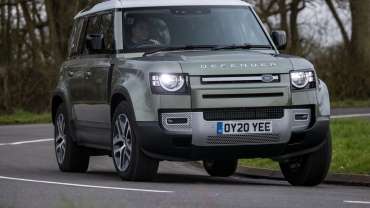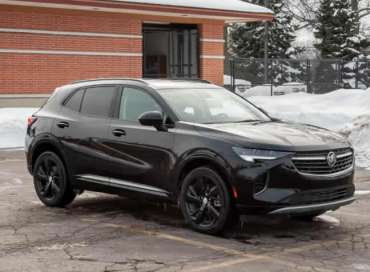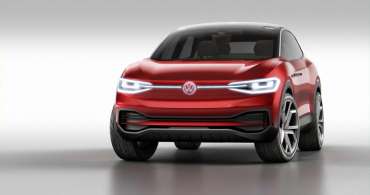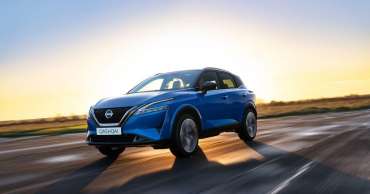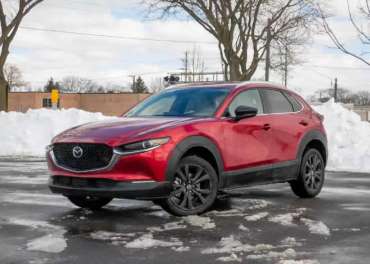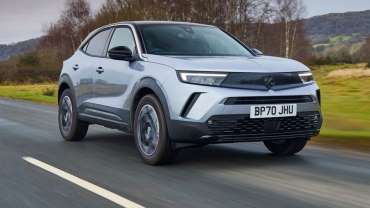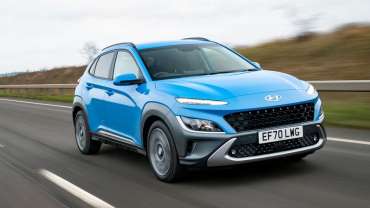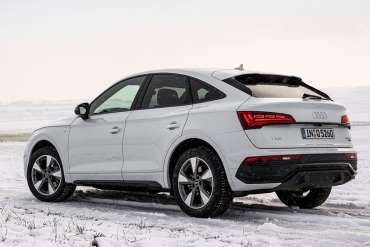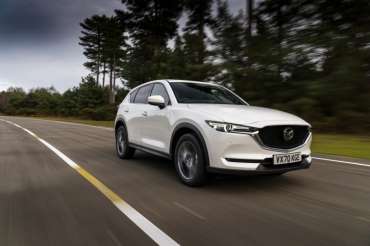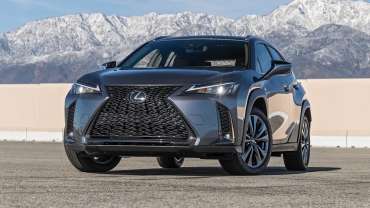Displaying items by tag: SUV
Land Rover Defender SUV review
"The Land Rover Defender has returned with an incredible repertoire of talents, including a strong range of plug-in hybrid, petrol and diesel engines"
This is the all-new Land Rover Defender, the long-awaited, much-hyped replacement for Britain's most famous SUV. It returns some four years after production of its predecessor stopped, and manages to be both similar and yet significantly different.
Its design clearly pays tribute to the original ‘Landie’, albeit in original new ways, and Land Rover still claims it's the best off-roader you can walk into a showroom and buy. However, its advanced technology, improved performance, luxury and safety kit mean the Defender has been parachuted into the 21st Century.
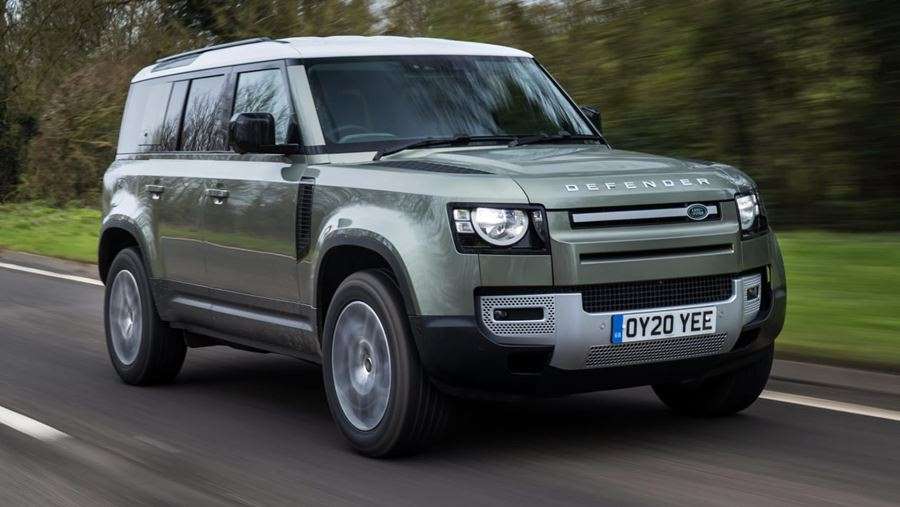
We'll let you decide whether its design is a success, but it certainly looks appropriately chunky, and details like its front and rear lights are impressively intricate. There are plenty of personalisation options too. It may be that you love the basic Defender with steel wheels, but hate the range-topper with gargantuan alloys, or vice versa. Similarly you may prefer the looks of the three-door Defender 90 or longer five-door 110, and there’s an even lengthier 130 also in the pipeline.
Inside, the Defender has a rugged, industrial aesthetic, characterised by exposed bolt heads, metal surfaces and an exposed magnesium crossmember that forms part of the car’s structure. It's also unique thanks to an optional jump seat between the front occupants that can make the 90 or 110 a six-seater. A third row of seats is also available for the 110.
Passengers are treated to the latest in-car entertainment and connectivity, with Land Rover's Pivi Pro system using two modems to ensure it can be wirelessly updated, even while being used for media, navigation or traffic updates.
At launch, a pair of four-cylinder 2.0-litre diesel engines with 197 or 237bhp were available, badged D200 and D240 respectively. These have now been replaced by a pair of 3.0-litre six-cylinder engines with mild-hybrid electrical assistance. In base D200 trim, this engine produces 197bhp, which increases to 247bhp in mid-range D250 spec and 296bhp in the range-topping D300 version.

The entry-level P300 petrol is unchanged with a 2.0-litre four-cylinder engine producing 296bhp. For those wanting more power, a 394bhp 3.0-litre straight-six petrol P400 mild hybrid is also available in the top X trim, but a starting price of £81,000 means it probably won't be a common sight on UK roads.
A P400e plug-in hybrid was introduced as part of the 2021 revisions and is the first PHEV powertrain in the history of the Defender. This model combines a 2.0-litre four-cylinder petrol engine, an electric motor and a battery pack, and is the most powerful Defender available, producing 398bhp.
The PHEV version is the fastest Defender until Jaguar’s Special Vehicle Operations division creates a high-performance V8 model, which is expected later this year. The entry-level diesel costs from £45,000 and every version has an eight-speed automatic gearbox, low-range gears and four-wheel drive.
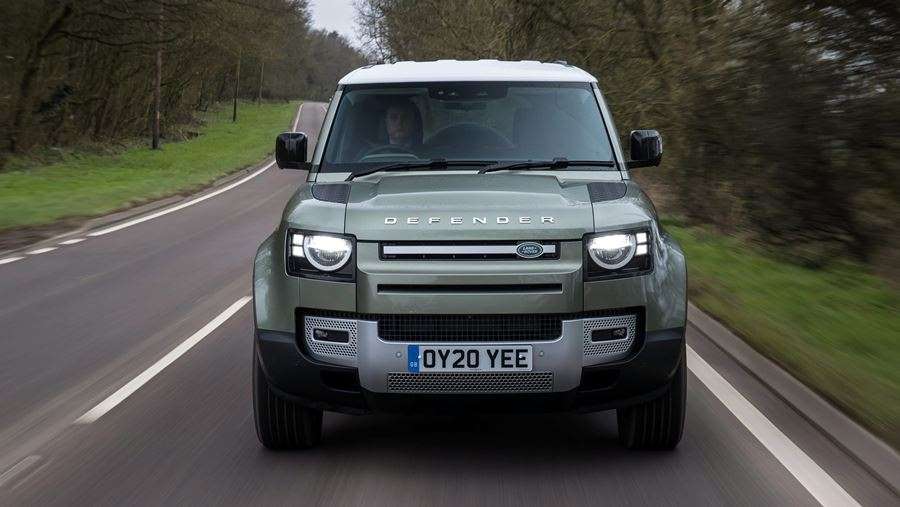
The D240 diesel is capable of getting the Defender from 0-60mph in a respectable 8.6 seconds, but it's the way the Land Rover feels to drive that's most surprising. The steering is direct and responsive, tucking the nose into corners with little hesitation and while there's some body roll, this suits the Defender's character. This is a Defender that's sporty and enjoyable to drive along a twisty road, thanks to the chameleon-like nature of its adaptive air suspension.
Off road, the same setup can extend, providing enough articulation to see the Defender crawl over almost any obstacle and wade through almost a metre of water. It's almost unstoppable off-road, and surprisingly comfortable while tackling the very roughest terrain. It can also tow up to 3,500kg and carry an unbelievable 300kg on its roof.
The Defender has always been innovative, and the latest version is one of the most intelligent cars we've ever tested. It may be rather uneconomical - at least until the plug-in arrives - but it makes up for this with impressive on and off-road manners, and an incredibly well considered design for demanding buyers, their passengers and all their gear.
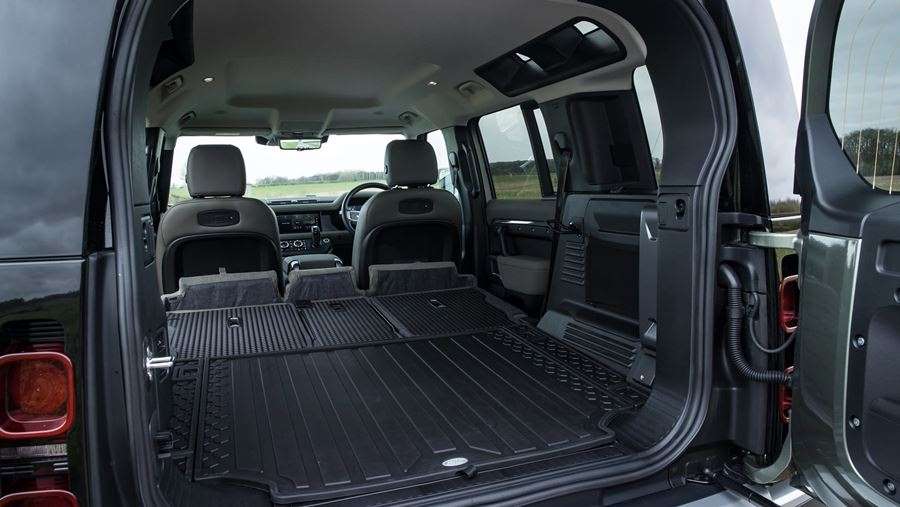
Land Rover Defender SUV - MPG, running costs & CO2
Defender buyers will be able to choose between diesel, petrol and mild-hybrid power, depending on what suits their needs and driving habits the best. Sadly, none provide especially low running costs.
Land Rover clearly prioritised performance, versatility and rugged looks over fuel-efficiency - just as they did with the original. Even the most economical version of the new Defender just manages to tip over 30mpg, while (WLTP) CO2 figures north of 230g/km mean company-car drivers will face a hefty Benefit-in-Kind bill.
Unlike the original Landie, which had the same commercial status as a van or pickup, the new standard versions of the Defender 90 and 110 are classed as private vehicles, with the van-like 90 and 110 Hard Top the only versions to be classed as commercial vehicles. A plug-in hybrid is now available, and we expect a range-topping V8 model to arrive in due course - details of the latter have yet to be confirmed.
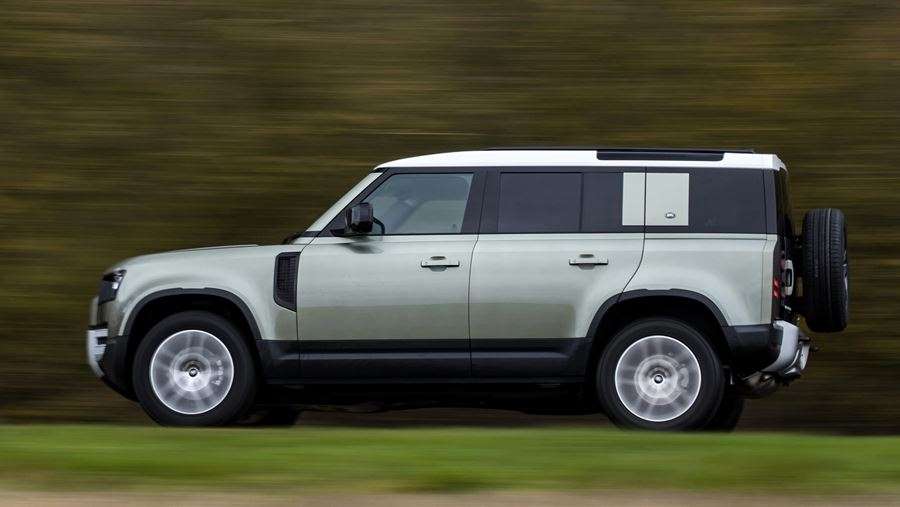
The Defender was launched with two diesel 'Ingenium' 2.0-litre turbo engines badged D200 and D240, returning up to 32.2mpg in the 90 and 31.7mpg in the Defender 110. CO2 emissions span from 230-253g/km (WLTP).
These have been replaced for 2021, with a new 3.0-litre straight-six diesel engine boasting mild-hybrid tech. The D200 version of this engine can manage around 32mpg, a figure which is closely matched by the more powerful D250 and D300 models. All three engines emit 231-233g/km of CO2.
The 2.0-litre turbo petrol P300 can manage around 24mpg with emissions of over 260g/km, the same ballpark figures as the 3.0-litre P400 mild hybrid. Thanks to its 19.2kWh battery pack, the P400e plug-in hybrid can manage up to 27 miles on electricity alone, giving it official figures of 85.3mpg and CO2 emissions of 74g/km. This should make it the cheapest Defender to run by some margin and the only one that should be on company-car shopping lists. It also just qualifies for free entry into the London Congestion Charge zone, sneaking under the current threshold by 1g/km.
The battery can be charged at home using a 7.2kW wallbox, taking it from 0-80% in two hours. It will also be possible to use a 50kW rapid-charger (using the supplied cable), for an 80% charge in 30 minutes.
Insurance groups
Insurance groups for pricey, complex SUVs tend to be a bit higher than for normal cars. That's certainly the case here, because even the entry-level D200 sits in group 31 out of 50, while the D240 First Edition sits in group 38. That's the same rating as the P300 petrol receives in SE trim, while the P400 X is in group 44.
Warranty
Land Rover provides a three-year/unlimited-mileage warranty with its new models, which matches BMW and Mercedes. It's not as generous as some brands, though; the Kia Sorento comes with a seven-year warranty as standard.
Servicing
Land Rover offers servicing plans that can help spread the cost of maintenance, so they're worth exploring with the dealership. It's also worth noting that diesel engines require AdBlue top-ups every so often.
Land Rover Defender SUV - Engines, drive & performance
The Land Rover Defender has a wider range of talents than almost any other vehicle on sale
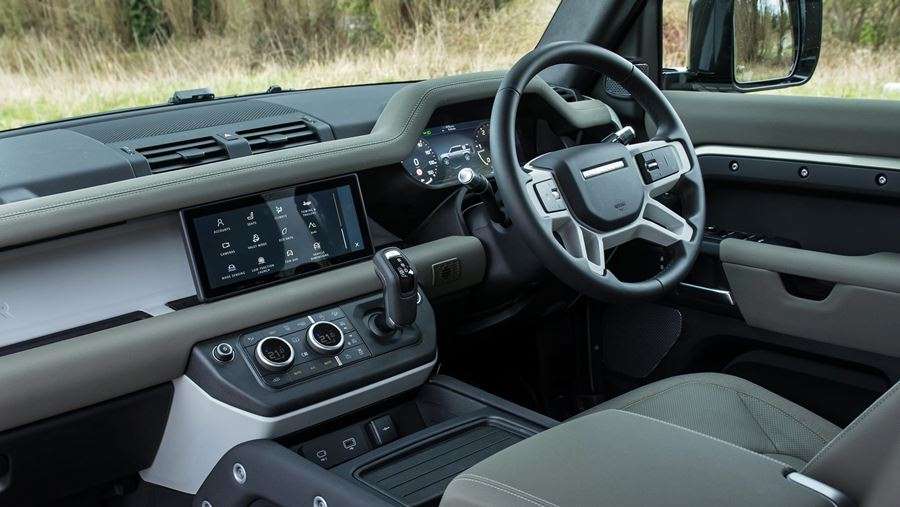
It might be one of the most loved models of all time, but one thing the Defender was never famous for was its everyday performance. Enough low-down grunt to get up steep bank and tow a trailer, yes, but not straight-line speed away from the lights.
With a more advanced powertrain, the new Defender has a far broader set of talents. Its advanced adaptive four-wheel drive and air suspension (on top trims) ensures it's still capable of traversing the world's most inhospitable terrain, but it can also tear from 0-62mph in as little as six seconds.
Just as impressive as its on-paper statistics, there's the fact it's simply fun to drive as well. Many have questioned whether the new Defender would tread on the toes of the Discovery, but from behind the wheel it instantly has a character of its own. Its steering is more alert and faster to react, while the Defender's air suspension is firmer and there's more feedback flowing back through your fingertips and the seat as you drive.
Attack a British road, and the Defender is instantly enjoyable and feels surprisingly sporty, digging its front tyres into the road. It's remarkably composed too; the fact the body leans slightly through faster corners and the nose lifts under acceleration only seems to add to its character.
Yet, the same suspension can transform to scale ruts, wade through deep water and absorb torturous bumps. Every Defender is fitted with an eight-speed automatic gearbox that also has low-range ratios designed for off-road driving and towing. At Eastnor Castle's off-road experience centre, sections have been opened up for the first time in a decade to test the Defender's extreme capabilities. A set of tortuous undulating water-filled pits is a particular challenge, and just when you think the Defender is about to get stuck, its Terrain Response 2 software modulates power to the wheels to find just enough traction to drag it out the other side.
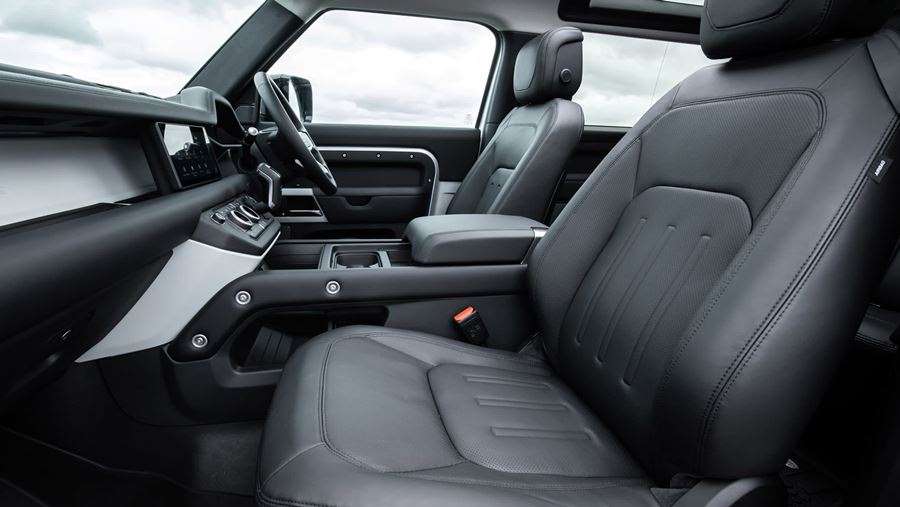
Designed around Land Rover's new D7x platform that's incredibly stiff - and has been subjected to years of rigorous testing during its development - the Defender has approach and departure angles of 38 and 40 degrees respectively, along with a 900mm wading depth. It can tackle 45-degree side slopes and inclines, and its Terrain Response 2 system can be used to adjust the chassis and differentials manually or simply be left in Auto, where it recognises the surface you're driving on.
The Defender launched with two versions of the 2.0-litre 'Ingenium' diesel engine, badged D200 and D240, with the same 430Nm of torque but 197 and 237bhp respectively. Both get an automatic gearbox and permanent four-wheel drive as standard, and cover the 0-60mph dash in 9.9 seconds and 8.7 seconds.
Early impressions are that it's the best use of the engine yet, and we especially like how Land Rover has altered its sound. This has been done by augmenting engine noise using the car's audio system, with the resulting background noise more like a rumble than a high-pitched diesel growl. A sensitive throttle pedal means the D240 engine also feels impressively responsive.
Land Rover is already replacing them with larger 3.0-litre straight-six diesel engines equipped with mild-hybrid hardware. These are badged D200 (with 197bhp), D250 serving up 247bhp and D300 with 296bhp. Acceleration from 0-62mph takes 10.2, 8.3 and 6.7 seconds respectively.
Petrol engines
Unlike the previous iteration of Defender, buyers can choose between two petrol engines, badged P300 and P400. The smaller 2.0-litre turbo gets 296bhp, propelling the car from 0-60mph in 7.6 seconds, while the 3.0-litre straight-six P400 has 395bhp and gets to 60mph in six seconds.
The P400 is also fitted with 48-volt mild-hybrid electrical assistance, designed to harvest the energy normally wasted under deceleration and store it in a small lithium-ion battery. This can be used to bolster the engine's torque under acceleration and provide stop and start more of the time when waiting in traffic.
It's the most fun version to drive, for now, with a tuneful sound from its six-cylinder petrol and impressive acceleration. Interestingly, there are no steering wheel-mounted paddles for the automatic gearbox, as engineers don't feel they fit the Defender ethos, but you can nudge the gearstick to shift manually. The engine and steeringing again feel surprisingly willing for a big, heavy SUV.
Plug-in hybrid engines
The Defender P400e plug-in hybrid uses a 2.0-litre petrol engine, electric motor and a 19.2kWh lithium-ion battery. With a combined 398bhp, it's the fastest Defender available until an anticipated performance model arrives with a V8 engine, getting from 0-62mph in 5.6 seconds. Unfortunately, the P400e is limited to the Defender 110 model. Air suspension and 20-inch alloy wheels come as standard.
Land Rover Defender SUV - Interior & comfort
Former Defender owners won't recognise the level of luxury and comfort on offer
The Defender's interior is like nothing else on the market today, combining retro nods to the original like exposed screw heads and bare metallic surfaces, along with the debut of new technology for the entire Land Rover brand.
As you'd hope, there are also innovations, such as a system that uses real-time camera feeds to offer a view of the obstacles immediately ahead without the nose of the car getting in the way. ClearSight can also be used to provide an uninterrupted rear-view mirror, even if the Defender is loaded with passengers and luggage or the rear window is caked in mud.
Fans of industrial design will adore touches like the powder-coated aluminium surfaces and magnesium bulkhead, the latter being a functional part of the Defender's body structure. It's undeniably tough-looking, and its extreme off-road capabilities are reinforced by the quantity and sturdiness of grab handles for passengers to cling onto. The flat, horizontal shapes are clearly a nod to its predecessors, as is the jutting centre console with a stubby gearlever and oversized switchgear.
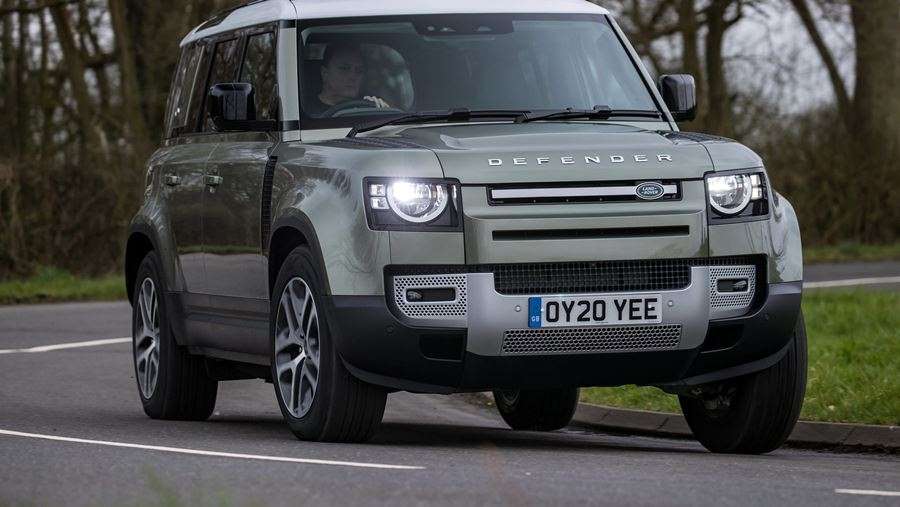
But it's not completely retro; there's a modern aesthetic not unlike the design of the latest Apple Mac Pro. The 10-inch Pivo Pro infotainment system is all new, using dual-eSIM modems that can receive over-the-air software updates and provide media and navigation without interruptions. An auxiliary battery also means it can work in the background even when the Defender is parked up, and resume more quickly. It also supports a mobile app that can be used to interact with the Defender and set the climate control remotely.
Equipment
Land Rover certainly hasn't held back when it comes to offering a wealth of trim levels and customisation options to customers. Even the trim levels are somewhat overwhelming, with Defender, S, SE, HSE, First Edition and X all offered, along with a myriad of options that even extend to what sort of roof you'd prefer.
The standard 110 model comes fitted with rather appealing 18-inch gloss white steel wheels, LED headlights, heated front seats, the 10-inch Pivi Pro system, surround cameras, cruise control and air suspension. S adds 19-inch alloy wheels, leather upholstery and digital instruments, while SE upgrades the headlights with a 'signature' look for the daytime running lights, along with keyless entry, 20-inch wheels and ISOFIX for the front passenger seat. It also adds some key features like a 10-speaker stereo, electric steering column and ClearSight rear-view mirror.
HSE increases the luxury further with a folding fabric roof (Defender 90 only, with a sliding panoramic roof for the 110), Matrix LED headlights, extended leather interior and a heated steering wheel. The range-topping X gets a black roof and bonnet, black exterior trim, orange brake calipers, front skid plate and tinted rear lights. It also has more off-road hardware, but you wouldn't know it inside thanks to Walnut veneer, heated rear seats and a 14-speaker stereo. It's also only available with the most powerful D300 and P400 engines.
Options
It's hard to know where to start with the Defender's options, but rest assured its packs and accessories cover every eventuality, from a tow bar to a ramp that makes it easier for your dog to clamber into the boot.
A good kicking off point is the curated equipment packs called Explorer, Adventure, Country and Urban. Explorer adds the famous snorkel air intake, a roof rack, waterproof side-mounted gear carriers, a matte black front badge and items like mud flaps and a cover for the spare wheel.
The Adventure pack includes an on-board pressure washer (with a 6.5-litre tank) designed for rinsing off boots and outdoor sports gear, scuff plates, mud flaps, and an integrated air compressor. There’s a similar roster of add-ons in the Country pack. In contrast, the Urban pack adds metal pedals to the interior, while rear bumper scuff plates, a spare wheel cover and front skid plate protect the exterior.
Land Rover Defender SUV - Practicality & boot space
Configured wisely, the Land Rover Defender offers serious load-lugging abilities
Like the rest of the Defender's attributes, the practicality on offer is also highly flexible and customisable. The biggest decision facing buyers will be whether to go for the five-door 110 model, or the three-door 90. An even larger Defender 130 with eight seats is also expected to arrive later on.
Land Rover Defender interior space & storage
Choose the three-door 90 and the Defender can still carry up to six people. That's thanks to a unique jump seat between the front seats, made possible by the dashboard-mounted gearlever. It's big enough for kids, and when the optional middle seat isn't in use, folding it forwards transforms it into a large central armrest and cubby. The biggest sticking point is the lack of rear doors because anyone getting in the back has to climb rather high to negotiate the front seats.
The 110 is also offered in a 5+2 layout, which is Land Rover speak for adding two smaller seats in the boot. These are best suited to kids but adults may also be able to travel for shorter hops in a pinch.
There are also handy features like USB or 12-volt power sockets for charging portable devices, a backpack that secures to the rear seat and 'click and go' system for middle-row passengers to attach tablets, bags, laptops and jackets. Then there are innovations like the side mounted 'Gear Carriers' that are 24-litre lockable and waterproof containers that mount on the Defender's rear window pillars in a similar fashion to motorcycle saddle bags.
The five-seat Defender 110 has 1,075 litres of cargo space behind the seats, expanding to a massive 2,300 litres when the seats are folded down. A rubberised floor is designed to shrug off spills and be brushed or wiped clean. The Defender 90 is notably less spacious, with a shallow 397-litre boot that's smaller than a Honda Civic's.
It's worth noting that the Defender has a traditional side-hinged tailgate, not a hatchback like most of the SUVs currently on sale. This can be fairly heavy (it also carries a full-size spare wheel) and will require some room behind the vehicle to open fully. However, it does open on the correct side for UK roads, with the opening towards the kerb, and is a characterful nod towards its predecessor.
Towing
Defenders have long been used for towing, and the latest version is seriously capable. It can pull a 3,500kg braked trailer, and the Defender itself has a maximum payload of 900kg. It can also accept a static load on its roof of up to 300kg.
2021 Buick Envision Review: Premium Value
The verdict: The redesigned 2021 Buick Envision premium compact SUV is stylish and refined, and has easy-to-use tech features, but poor brake-pedal feel degrades the driving experience.
Versus the competition: Sized like a compact SUV but priced below subcompact luxury models, the 2021 Envision gives shoppers who aren’t concerned with having a traditional luxury badge a lot of value for their money.
The 2021 Buick Envision newly shares its platform with the Cadillac XT4 compact luxury SUV, and it’s wider, lower and slightly shorter than the model it replaces. Despite the redesign, it remains one of the few vehicles sold in the U.S. that’s built in China.
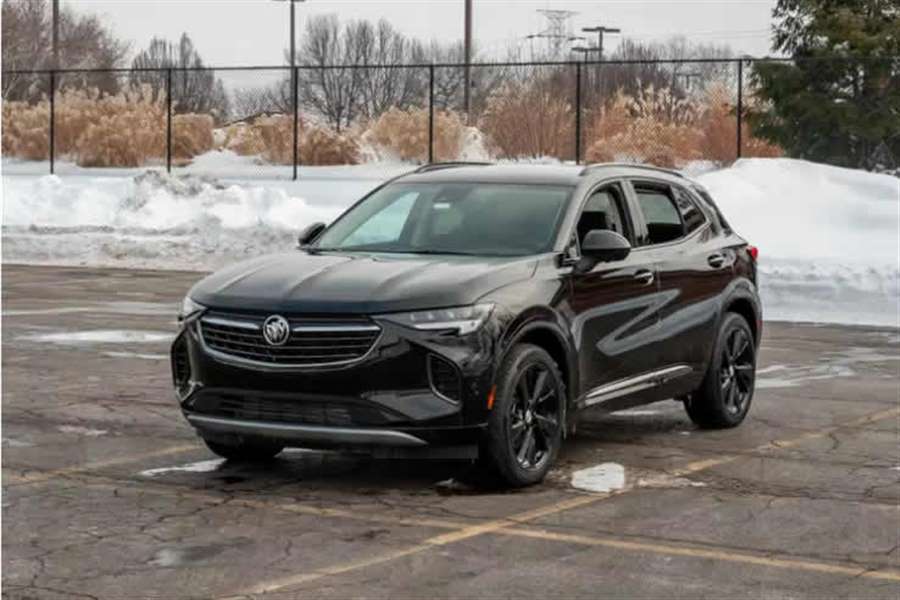
The 2021 Envision is also less expensive than its predecessor; a base Preferred trim level with front-wheel drive starts at $32,995 (including a $1,195 destination charge), which is $1,700 less than the starting price of the 2020 Envision. Our test vehicle was a mid-level Essence trim with front-wheel drive, and its as-tested price of $41,315 included a $2,500 Technology Package and a $1,325 Sport Touring Package, the latter featuring black exterior accents and 20-inch aluminum wheels. All-wheel drive is available on any trim for an extra $1,800.
How It Drives
All Envisions are powered by a 228-horsepower, turbocharged 2.0-liter four-cylinder engine that works with a standard nine-speed automatic transmission. The engine is smooth, refined and delivers adequate acceleration, and it produces a bit of a growl when you really step on the gas pedal. With nine forward gears, the automatic makes frequent upshifts when accelerating from a stop. The shifts are smooth, but there’s a short pause between gear changes. Part- and full-throttle kickdowns, however, happen without delay.
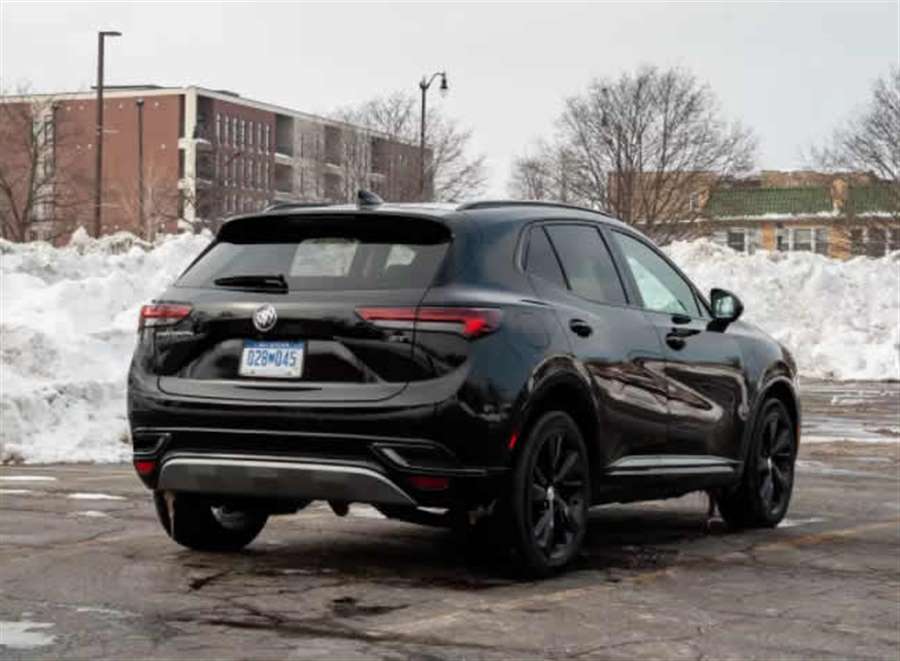
The SUV steers with a light touch, and the suspension deals swiftly with impacts from broken pavement. Body motions are well controlled overall, but the suspension tuning is on the firm side. This was especially noticeable on one stretch of road with small buckles in the asphalt, one after the other, that resulted in a choppy ride. Our test vehicle’s 20-inch wheels and low-profile tires likely didn’t help matters, and it’s possible the standard 18-inch wheels with taller-sidewall tires offer more comfort. Ditto for the top Avenir trim level’s available adaptive suspension, though experience has revealed that advanced suspensions don’t always compensate for large wheels.
The Envision’s brake-pedal feel was disappointing on a number of fronts. Pedal feel is numb, and it suffers from poor linearity on top of that. We’ve experienced this unpleasant combination in certain gas-electric hybrids, but it’s less common in conventionally powered vehicles like the Envision. Like many hybrids and a growing number of conventional vehicles, however, the Envision has a brake-by-wire system with electric assist rather than traditional vacuum-assisted power brakes. (We reported similarly disappointing braking feel in our review of the XT4, the Envision’s platform mate.)
The front-drive Envision is EPA-rated at 24/31/26 mpg city/highway/combined, while all-wheel-drive versions are rated 22/29/25 mpg. More powerful compact luxury SUVs like the Acura RDX and Lincoln Corsair get slightly worse estimated gas mileage, but the smaller BMW X1 has slightly better ratings (see fuel economy estimates for front- and all-wheel-drive versions of these SUVs).
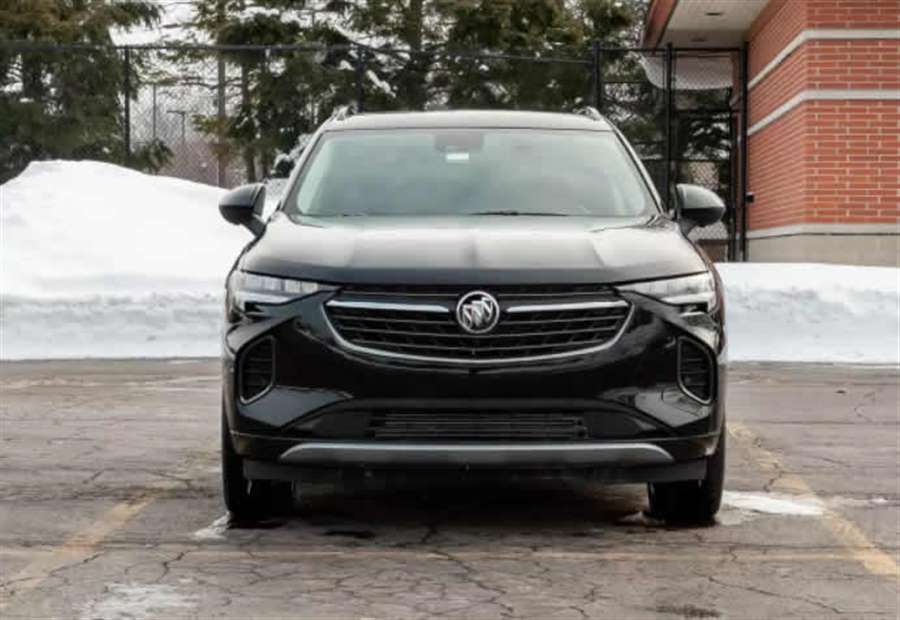
The Interior
Interior quality is good overall with soft-touch surfaces closer to eye level and hard plastic near your feet. Our test vehicle’s all-black color scheme, however, looked a bit dour to my eyes. A beige interior is also offered.
Frequently used controls are within easy reach of the driver, and the center of the dash is dominated by the optional 10.2-inch touchscreen (an 8-inch touchscreen is standard in the Preferred trim). The big screen is responsive, has an intuitive interface and looks great. There are also handy volume and tuning knobs to the left of the screen.
Both touchscreen systems include wireless Apple CarPlay and Android Auto smartphone connectivity, but only the Avenir trim includes wireless device charging. Connecting my iPhone to the multimedia system was easy, and the wireless CarPlay connection seemed just as responsive as the more common wired setup.
One of the more unique elements of the interior is the gear selector, which consists of a column of buttons and pull switches that go where a conventional shifter channel otherwise would. It didn’t take long to get accustomed to the system, but the design doesn’t result in any additional storage space on top of the front center console; there’s a small forward bin, two cupholders to the right of the shifter and a storage bin under the front center armrest. The design does, however, eliminate the obstruction a lever would represent, and its electronic nature allows for an open lower storage area below the console.
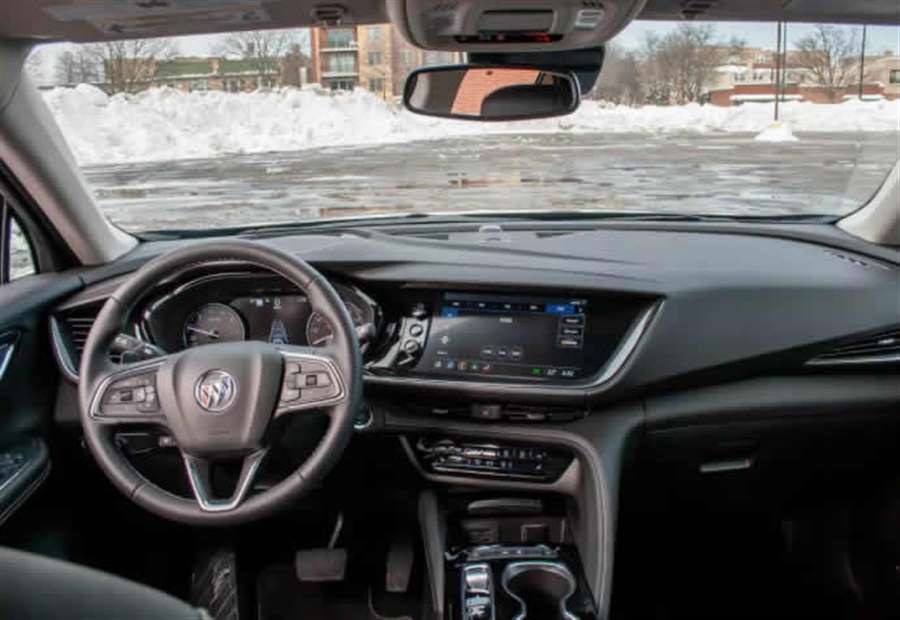
The Envision’s front bucket seats are comfortable, and they’re finished in cloth and simulated leather (Preferred) or perforated real leather (Essence and Avenir). The seats have modest side bolsters that don’t hold you in place when taking a corner quickly, however.
There’s surprisingly good rear-seat space for adult passengers. The bench seat is comfortable and there’s good headroom. The standard 60/40-split backrest folds flat with the cargo floor, extending the luggage area, but the seatback doesn’t recline.
Safety
Neither the Insurance Institute for Highway Safety nor the National Highway Traffic Safety Administration had crash-tested the 2021 Buick Envision as of publication. The list of standard active-safety features includes forward collision warning with automatic emergency braking, blind spot warning with rear cross-traffic alert, lane-keeping assist and automatic high-beam headlights. A head-up display, 360-degree camera system and adaptive cruise control are optional.
Value in Its Class
The Envision doesn’t fit neatly into the mainstream or luxury compact SUV classes, but to hear Buick tell it, that’s an opportunity. Rob Peterson, the brand’s marketing manager, said Buick serves shoppers moving up from mainstream brands and has both the Envision and the smaller and less expensive Encore GX to offer small SUV shoppers.
There are still some mainstream elements like cloth upholstery and manual air conditioning in base Envisions, but the mid-level Essence trim swaps them and more for upscale amenities without significantly ballooning the price tag. It’s a value recipe that seems right for the times.
Volkswagen started producing another electric SUV: ID.5
Production of the first pre-series copies of ID.5 has begun, while the start of production of models intended for the market is expected in the second half of the year. The new model should be reminiscent of the ID.Crozz concept, and it is certainly a coupe version of the already known Volkswagen electric SUV - ID.4.
The German car giant Volkswagen continues with the offensive on the electric car market, so it has already started the production of the third electric model based on the MEB platform, reports zimo.dnevnik.hr.
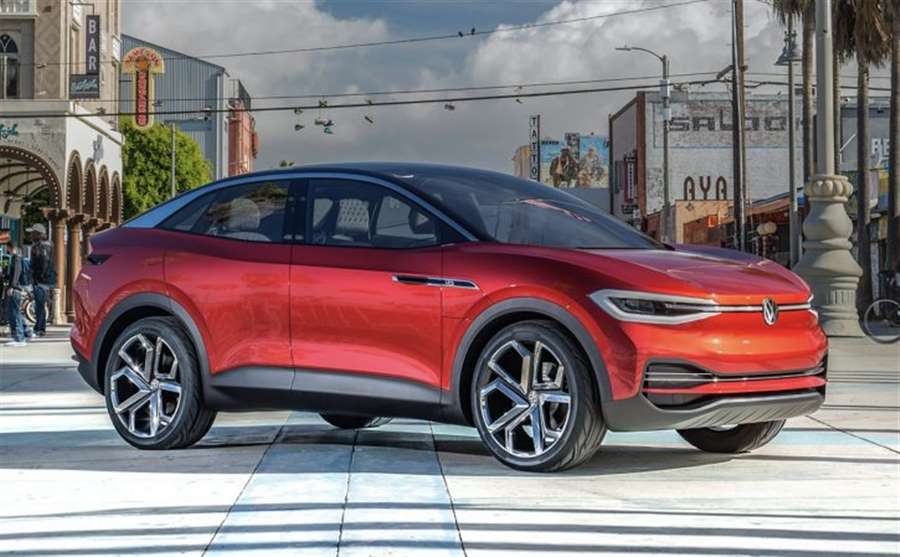
Sales of the ID.3 model (which should play the role of an electric Golf on the market) began last year, followed by the compact ID.4 SUV. Several other models are in preparation, such as the family ID.6, whose photos were recently leaked in China, and which you can see here, and ID.2 is mentioned. However, the first comes next - ID.5, an attractive SUV in the form of a coupe.
As ID.5 is not yet official, there is no data on its performance, but according to rumors, this will be a coupe version of the ID.4 model, which should look like the ID Crozz concept.
Although it has not been officially presented yet, the German company confirmed that the production of pre-series models has already started, while the production of the final versions is expected in the second half of the year.
Interestingly, like the ID.3 model, the "five" will not be intended for the United States, but the primary market will be European.
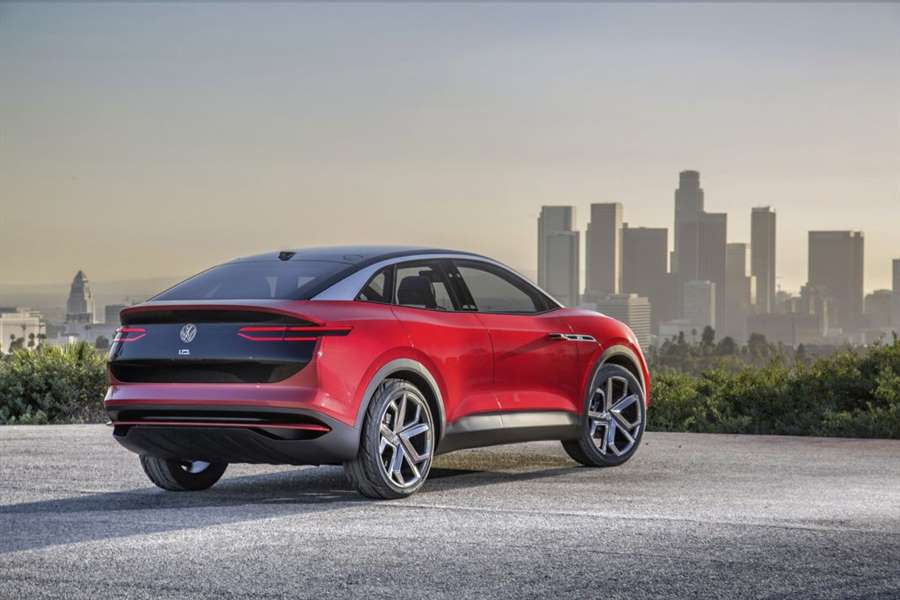
In terms of options and performance, it is speculated that the figures will be similar to those on the ID.4 model. Thus, the 150 kW engine that drives the rear wheels is mentioned (versions with two engines and all-wheel drive will appear later), as well as the 77 kWh battery.
Given that the start of production is expected in the second half of 2021, it is clear that Volkswagen will not wait too long until the official presentation of this model.
Pictures of the concept on which ID.5 is supposedly based indicate that this may be the most attractive electric "Volkswagen" which, if the price is not too high, could really achieve great market success, and perhaps be a bestseller in the e-SUV class. German companies.
This is a brand new Nissan Qashqai! Now without a diesel he is shooting at the top of the class again
The third generation no longer has diesel engines, which as an alternative come with hybrid versions of the existing turbo gasoline
Three million copies sold in Europe and a total of five million worldwide. A nice number for both previous generations of Nissan Qashqai, a mega-popular SUV of the compact class, well accepted among Croatian buyers of this class. Great numbers and history, but which set a high bar of expectations from the newly introduced new model.
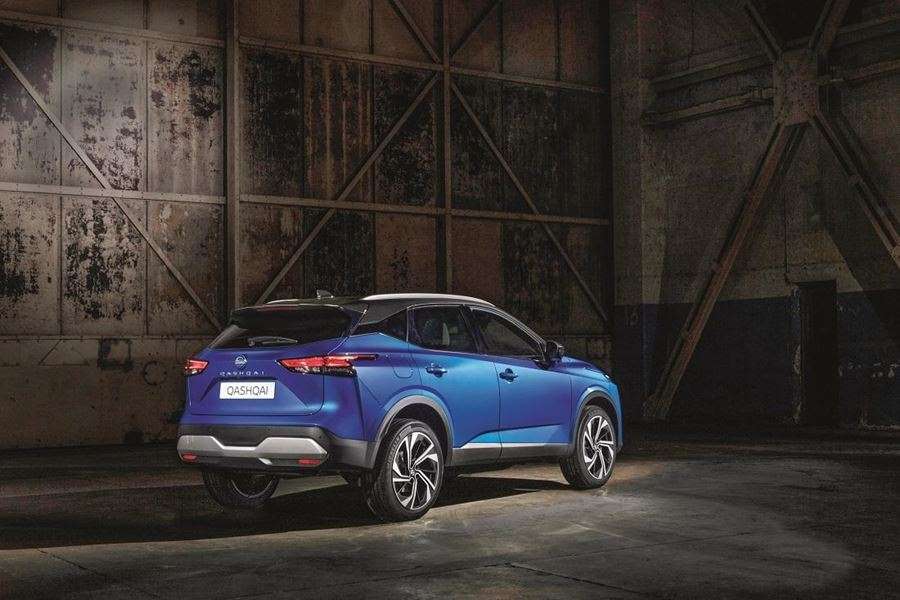
Nissan Qashqai, photo: Nissan
There is not much to say about design, the first step in appearing in front of customers. Qashqai retains the recognizable idea and lines of the previous model, but with cleaner lines, some details performed as a variation on the theme of Juke and Nissan's signature with a mask in the characteristic V-shape. A dose of modernism is given to it by details such as self-regulating, smart LED Matrix lights, 11 body colors, five two-tone combinations and rims that reach up to 20 inches as standard. The first photos create the impression of growing size and - that's right.
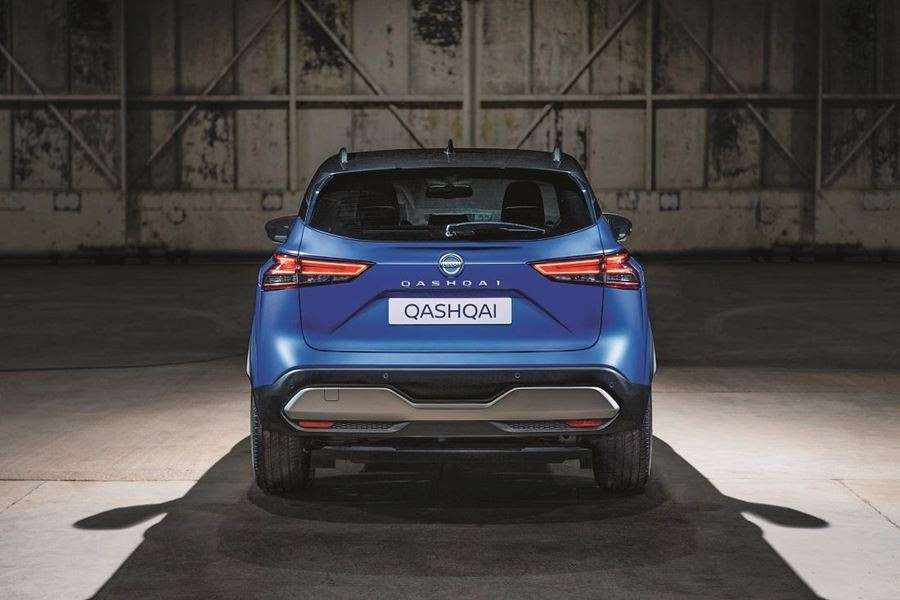
Nissan Qashqai, photo: Nissan
It is 3.5 centimeters larger (4,425 m), 3.2 centimeters wide (1,838 m), one centimeter high (1,635 m), and the larger corporate Renault-Nissan CMF-C platform, two centimeters larger axle, gives the impression of size. spacing (2666 mm). The result?
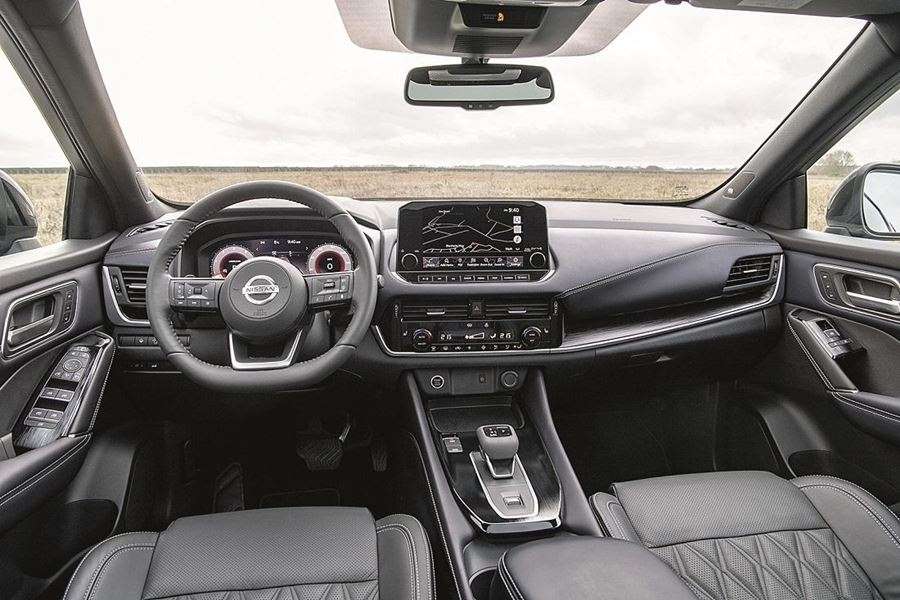
Nissan Qashqai, photo: Nissan
Round three centimeters more space for the passenger's knees in the rear seat (maximum 61 centimeters), a centimeter and a half more headroom and significantly more space in the front seats, where two-meter-tall people will also have a comfortable position. The rear pair of doors opens up to 85 degrees, which greatly facilitates access to the rear seat, and especially the placement of children in the seat.
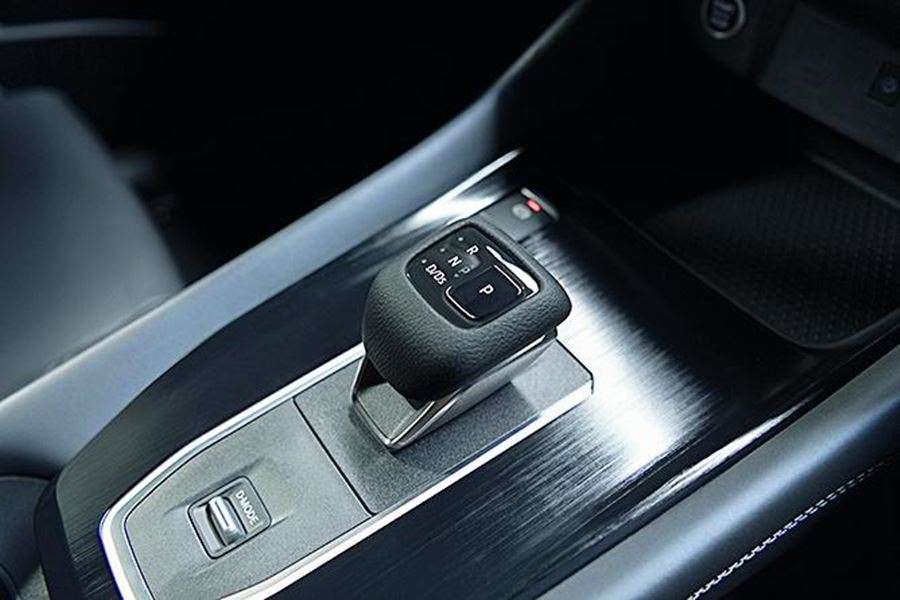
Nissan Qashqai, photo: Nissan
On top of all that, the trunk grows, by 50 liters, in this class more suitable 480 liters. It will be easier to access because the entry threshold is lowered by two inches. Aluminum alloys are also used more in the construction of the body, so let's say four side doors, fenders and a roof bring total savings of 21 kilograms. The fifth door is now made of composite materials and is 2.6 kilograms lighter, and the platform itself on the scales shows 60 kilograms less than the previous one. Niisan engineers swear that it is almost half as strong, or 41 percent.
The interior also boasts noticeably better materials, including nappa leather, a generally more expensive visual and sensory atmosphere, but also hedonistic elements of equipment such as massage seats or a concert Bose Premium hifi system with 10 speakers.
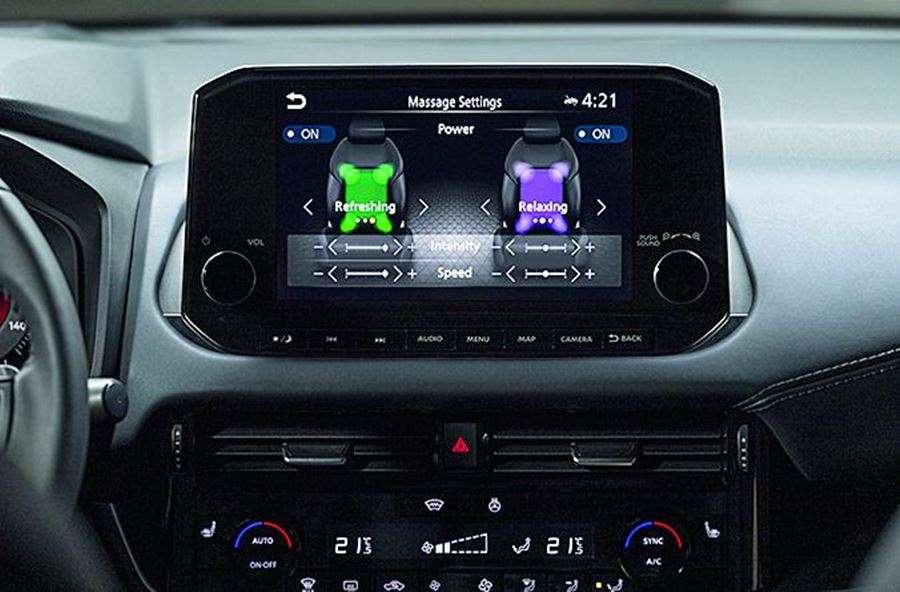
Nissan Qashqai, photo: Nissan
Digitization has also knocked hard on Qashqai’s doors. Large digitized 12.3-inch instruments, advanced multimedia with a 9-inch 3D screen, innovative and largest-in-class head-up 10.8-inch screen, interesting animations and wireless mobile charging are part of the new ambience accompanied by a smartphone app which will be able to control the secondary functions. Furthermore, the ProPilot safety system gets a connection to the navigation and detects real and potentially dangerous events in front of and around the car faster and more accurately. The system comes in versions with automatic transmission.
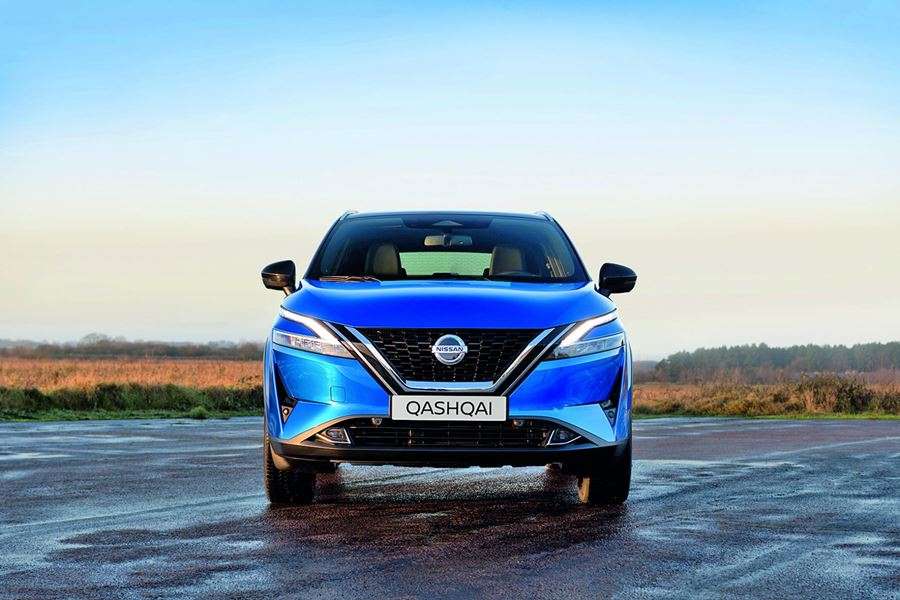
Nissan Qashqai, photo: Nissan
One of the significant innovations will be the electrification of the drive, in terms of a 12-volt mild hybrid version of the famous 1.3 turbo gasoline known designation DIG-T (Direct Injection Gasoline-Turbo), upgraded to 50 components. Mild hybridization does not affect the change in rated power, which is maintained at 140 and 158 hp with torques of 240 and 260 Nm, but will have positive effects on reducing consumption and have the function of giving additional momentum of power and torque when accelerating. The base engine has front-wheel drive and a six-speed manual transmission, more powerful as well, but it comes with four-wheel drive 4x4 and a new-generation X-tronic automatic transmission (CVT) as options. With automatic torque increases to 270 Nm.
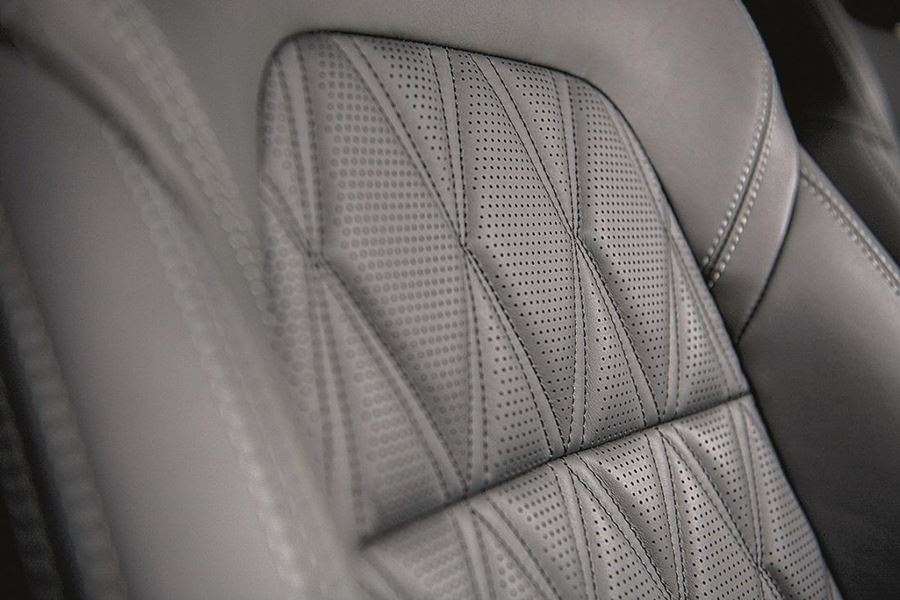
Nissan Qashqai, photo: Nissan
The hybrid system carries 22 pounds of weight. An interesting hybrid version of the e-Power unusual operating principle has also been announced, in which the 1.5 turbo petrol engine has a secondary function in relation to the electric motor. The total power output is 190 hp, but the story is somewhat reversed compared to classic hybrids. The petrol is basically not used for propulsion, but primarily for charging a powerful battery and transmitting power to an electric motor that drives the wheels itself, so the ride is very reminiscent of driving an electric car.
The Qashqai also gets a single-pedal e-Pedal braking and acceleration system, known from the electric Leaf. With the new platform, the basis of a more complete driving experience will be thorough refinements on more precise and flexible steering wheel operation, but also filigree polished suspension, which remains semi-rigid in the standard versions, while 4x4 and top models with standard 20-inch wheels go multilink.
2021 Mazda CX-30 Review: More Fun, Still Flawed
The verdict: The 2021 Mazda CX-30 is refined in many ways, and a new turbocharged engine option elevates it as a value alternative to many entry-level luxury SUVs. Beyond that, it lacks too many commonsense attributes for mass-market appeal.
Versus the competition: Upscale and fun to drive even if you don’t get the new turbo engine — and legitimately quick if you do — the CX-30 will deservedly find its loyalists. But many mass-market competitors have simpler controls, softer rides and roomier cabins.
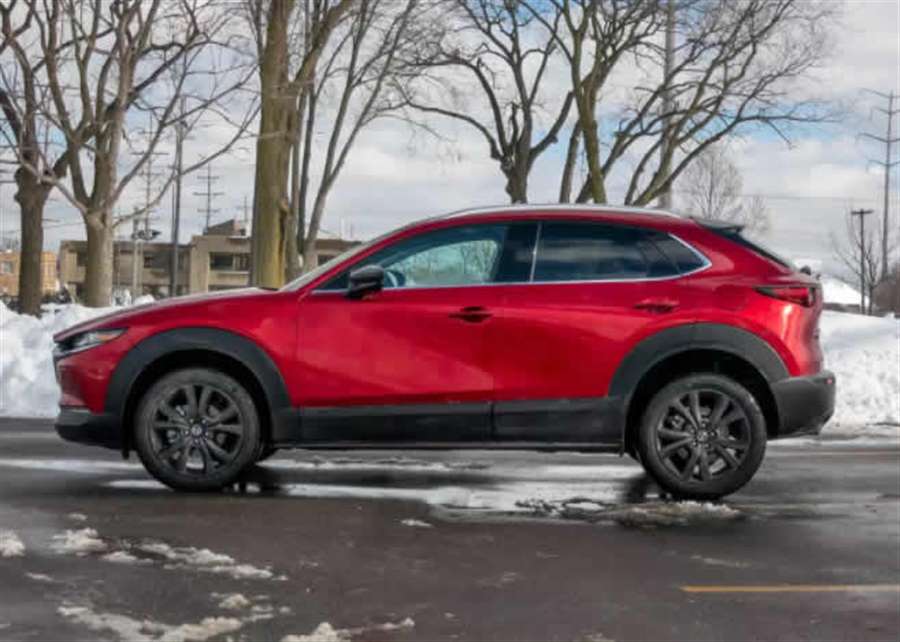
Based on the current-generation Mazda3 sedan and hatchback, the CX-30 enters its second model year for 2021 as a more viable alternative to the too-small Mazda CX-3 SUV. It comes in seven trim levels with front- or all-wheel drive and two available engines; stack them up or compare the 2020 and 2021 models. We evaluated a well-optioned turbo model for 2021, but I’ll mix in some impressions from the base-engine 2020 CX-30 that we tested in Cars.com’s recent Affordable Small SUV Challenge, where I served as a judge.
The CX-30’s third-place finish out of four SUVs in the comparison test tells much of the tale: Mazda’s small SUV drew top scores in some areas but bottom marks in others, with very little about it evoking neutral reactions. One model year later, Mazda plopped in a newly optional turbocharged four-cylinder, which matches the character of its carryover base engine: refined, steady power — just more of it. The fun’s been turned up, but the flaws live on.
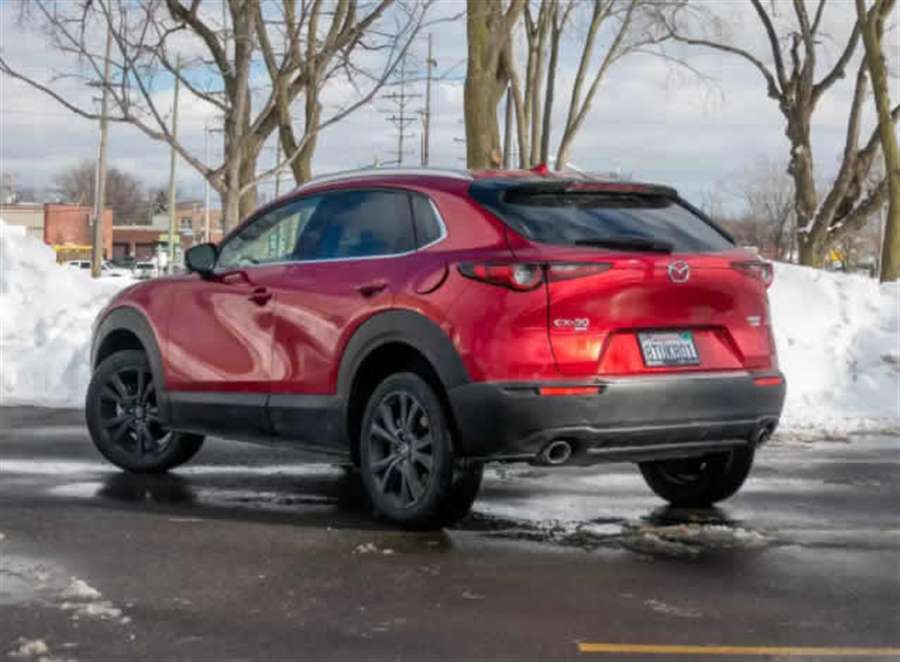
Refined Engines
In a field where pint-sized engines, many of them turbocharged, can lend tentative acceleration, the CX-30 is an old-school breath of fresh air. Its base engine, Mazda’s refined 2.5-liter four-cylinder (186 horsepower, 186 pounds-feet of torque) provides smooth if unspectacular power: sufficient from a start, with linear revving through any sustained on-ramp charge. It pairs with a six-speed automatic transmission whose tall gearing works against such drawn-out spurts — a disadvantage on paper, where rivals’ eight- or nine-speed units can make for shorter passing gears without diminishing fuel economy. But the six-speed earns its keep if you need more power while already in motion because downshifts are both decisive and immediate when you press the gas, an exercise many eight- and nine-speed automatics butcher.
Our comparison test exemplified how this plays out. We clocked a 2020 CX-30 with the 2.5-liter engine and AWD at a pedestrian 8.92 seconds to 60 mph, third slowest among four models (the others being a Chevrolet Trailblazer, Kia Seltos and Subaru Crosstrek, all with top available engines). Despite that, the CX-30 earned the group’s highest scores from our judges for overall powertrain impressions. Credit its consistent power delivery, which belies any absolute performance metric.

New for 2021 is Mazda’s turbocharged 2.5-liter engine, available only with AWD. It can run on regular gas but makes 250 hp and 320 pounds-feet of torque on 93-octane premium fuel, which our test car employed. (On 87-octane regular fuel, ratings for the turbo 2.5-liter drop to 227 hp and 310 pounds-feet of torque; the non-turbo 2.5-liter makes its output with either fuel.) Though significantly quicker past 2,500 rpm or so, the turbocharged four-cylinder’s power profile is similar to its non-turbo sibling — which is to say linear, building power over the full breadth of available engine rpm. Gearing remains tall, but the extra power makes the late upshifts less noticeable. And all the while, it’s gratifyingly quick.
The CX-30’s EPA-estimated fuel economy ranges from 25 to 28 mpg combined, depending on drivetrain. Versus a selection of mass-market rivals, the 2.5-liter falls a little short. Versus some entry-luxury models, whose interiors the CX-30’s top trims rival, the turbocharged CX-30 compares better.
Handling and Ride Comfort
Turbocharged or not, the CX-30’s reflexes are similar to the Mazda3 on which it’s based. Limited body roll, excellent steering feedback and surefooted brakes make the CX-30 a deft ally on winding roads. Wet conditions and temperatures in the 30s stymied our test car’s Bridgestone Turanza P215/55R18 all-season tires, which struggled on cloverleaf interchanges to hold course. Our CX-30 in the 2020 comparison had the same tires in better testing conditions, and we observed notable slippage there, as well. Wider or stickier tires might help — but if the CX-30’s rubber is the weak link on handling, it’s a mild one.
All that fun sacrifices ride comfort. Like the Mazda3, the CX-30 exhibits good overall straight-line composure, free of excess body movement on uneven surfaces; in this regard, it emulates a few entry-level luxury SUVs. But suspension tuning is unabashedly firm. The CX-30 exhibits a degree of impact harshness absent in many competitors, especially mass-market rivals like the Crosstrek and Nissan Rogue Sport — enough to turn off many shoppers who just want a smoother rider.
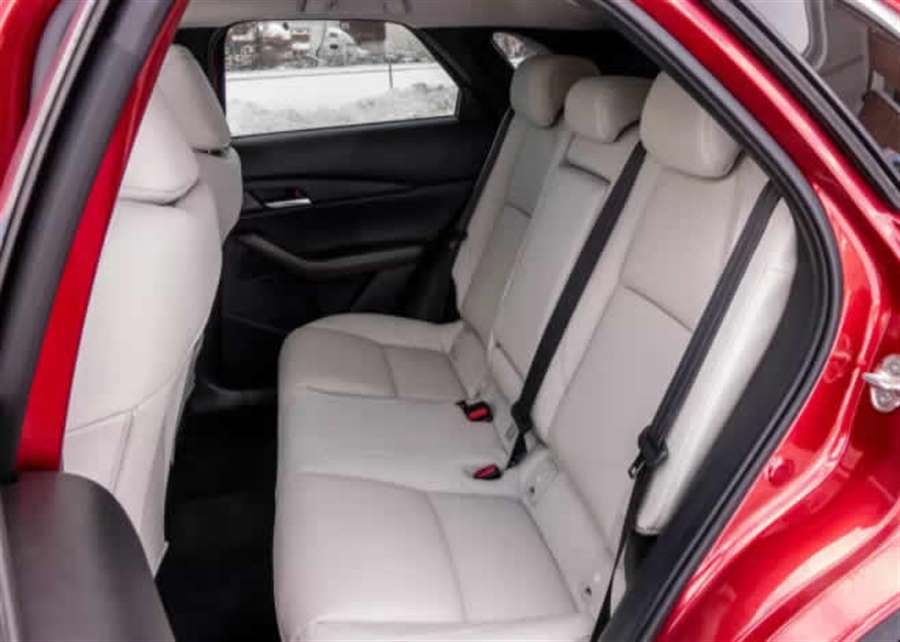
The Interior: Quality Over Quantity
For the most part, interior quality is strong. Controls boast meticulous detailing and operation, and most surfaces above knee level have consistent, low-gloss finishes. The CX-30’s optional leather seating surfaces are free of any obvious stretches of vinyl, and premium touches like universal one-touch windows hint at luxury territory. It’s not all excellent: A cheap headliner and some obvious cost-cutting in the backseat bring the CX-30 back to earth. By and large, though, this is a clear step above the SUV’s mass-market rivals. In our 2020 comparison, Mazda earned the highest interior quality scores by a clear margin, and in that regard may have fared well against SUVs priced far higher.
Despite that, interior quantity is marginal even if this is a larger alternative to the CX-3. The smallish backseat is ill-equipped to handle taller adults or even children in rear-facing car seats. Not only did it rank last in our comparison’s rear seats category, but it couldn’t fit Cars.com’s rear-facing child-safety seats without needing to move the front passenger seat so far forward that it may pose a safety risk for some adults seated there.
Even those who don’t plan to carry anyone in back often — children or otherwise — might find the CX-30’s confines, well, confining. The front seats have good sliding range but a narrow berth that could leave long-legged drivers feeling pinched. And as the CX-30’s relatively low-slung profile suggests, the driving position isn’t as high as you might expect of a conventional SUV. By our measuring tape, the CX-30’s driving position towers nearly half a foot above that of the low-riding Mazda3, but it trails the Seltos by roughly as much.
What’s more, the CX-30’s limited in-cabin storage and poor sight lines — especially out the rear window — are liabilities versus more utilitarian rivals; Mazda placed last in both categories (tied with the Crosstrek for storage) in our comparison. Cargo space, at 13.7 cubic feet by Cars.com’s independent testing, is a smidge above the Mazda3 hatchback (13.1 cubic feet, also by our accounting) and in the same neighborhood as the Trailblazer and Crosstrek, though the whole group falls well short of the Seltos’ as-tested 16.2 cubic feet.
Multimedia and Safety Technology
With the current-generation Mazda3 and now the CX-30, Mazda took a wayward turn on multimedia. No longer does the dashboard screen function as a touchscreen — even when the vehicle is stopped, as earlier iterations once did. It’s now a touch-free 8.8-inch display perched high atop the dashboard, controlled exclusively by a control knob and a few shortcut buttons on the center console. The setup especially stumps the CX-30’s standard Apple CarPlay and Android Auto integration, as both work best through a straightforward touchscreen.
Standard safety features include automatic emergency braking with pedestrian detection, lane departure warning with steering intervention and (impressively) adaptive cruise control down to a stop. The automatic braking passed third-party testing by the Insurance Information for Highway Safety, cementing the CX-30’s top scores across a battery of IIHS tests to earn the SUV a 2020 Top Safety Pick Plus award. (The award is likely to carry over for 2021, as the agency told us it has no plans to change criteria for the new calendar year.)
New for 2021, the CX-30 offers rear automatic braking, and top trim levels have new hands-on lane-centering steering by way of a feature called Traffic Jam Assist. Alas, TJA works only at speeds of 0-40 mph — a ceiling no longer imposed by most lane-centering systems available these days, regardless of price.
Should You Buy a CX-30?
Including destination, the CX-30 runs from just over $23,000 to about $36,000, a spread that overlaps a host of subcompact and compact SUVs to top out at the shores of the entry-luxury crowd. As a value alternative to the latter group, a CX-30 Turbo might justify itself; as a choice for driving fun among the mass-market models, a 2.5-liter example could also make sense. Given that the SUV ranks as Mazda’s second-best-selling model overall, it’s made the case to enough shoppers so far.
But larger market acceptance (the Crosstrek, for example, is three times more popular) will require a mainstream overhaul — a softer ride, bigger backseat, better visibility, simpler multimedia controls. As it stands, the normally aspirated CX-30 ranked in the bottom half of our 2020 comparison, and not for lack of quality or driving fun. With an infusion of high-end turbocharged trim levels, Mazda doubled down on everything we like, and it’s sure to get the CX-30 a cult following. But for all its remaining thorns, many mainstream shoppers may yet tune this Mazda out.
Source: cars.com
Vauxhall Mokka (2021) review: the ultimate glow-up
Your eyes don’t deceive you: this really is the new Vauxhall Mokka. We, frankly, didn’t quite believe Opel/Vauxhall design boss Mark Adams when he said that the GTX Experimental concept was a preview to this all-new crossover, built from the ground up using PSA platforms and technology.
Woah, what a change!
Definitely. Gone is the fuddy-duddy and dumpy looks of the Mokka’s predecessor, replaced with an all new and thoroughly modern look from Mark Adams and Co. The all-new Mokka is the start of a new design language from Vauxhall, with the new ‘Vizor’ front panel on the exterior, chunky wheelarches and sharp lines.

Inside, there’s a design revolution, too – going beyond even the new Corsa in terms of modernisation. It’s all part of Mark’s ‘Pure Panel’ mantra – keeping fuss to a minimum, and designing a dashboard that looks like it flows the digital instruments and central touchscreen in one. Other details include a super-minimalist shifter for the automatic gearbox versions, a lot like VW Group’s efforts with the latest Golf and A3.
Our SRi Nav Premium test car had supportive seats, with thick side bolstering and a kitch pattern on them. There’s ample adjustment in the driver’s seat, with allowance for drivers (like me) to whump it to the floor like a touring car driver. Material quality is good, with chunky indicator stalks and familiar PSA switchgear dotted around. The central touchscreen uses the much maligned PSA software, but arguably seemed to run faster here than previous experiences. Still, the digital instruments (seven inches on lower-end trims, 10 on higher) are clean and easy to digest, and come with varying layouts to suit you.
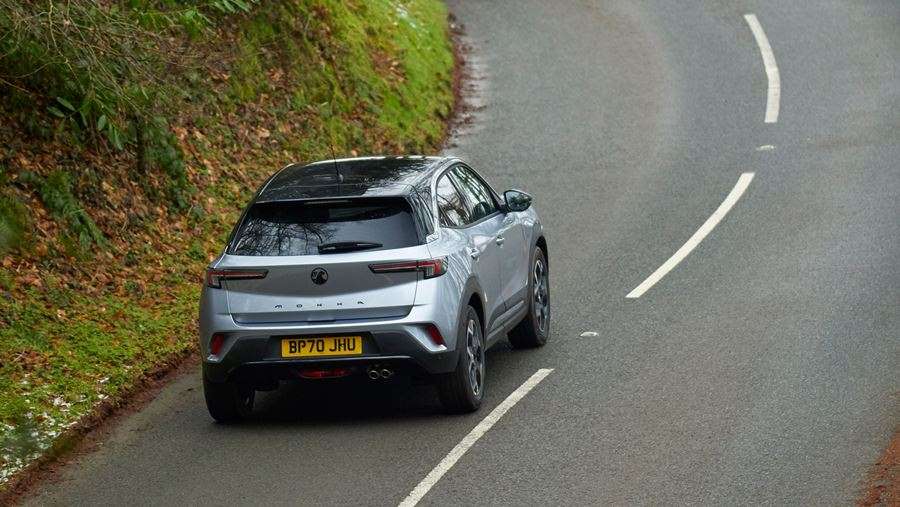
The only fly in the interior ointment is the rear space – tall adults might suffer sitting behind an equally tall driver in terms of legroom, but will have plenty of headroom. Boot space is rated at 350 litres, which is fine and adjusted with a movable boot floor, but the Mokka doesn’t excel here when up against myriad crossover rivals.
What engines can you get?
Vauxhall offers two 1.2-litre turbocharged petrol engines (99bhp and 127bhp – the latter available with an eight-speed auto) and a 1.5-litre diesel. Along with the combustion engine versions, Vauxhall offers the Mokka e, an EV with a 50kWh battery and 134bhp. We tested the 127bhp petrol with an eight-speed auto.
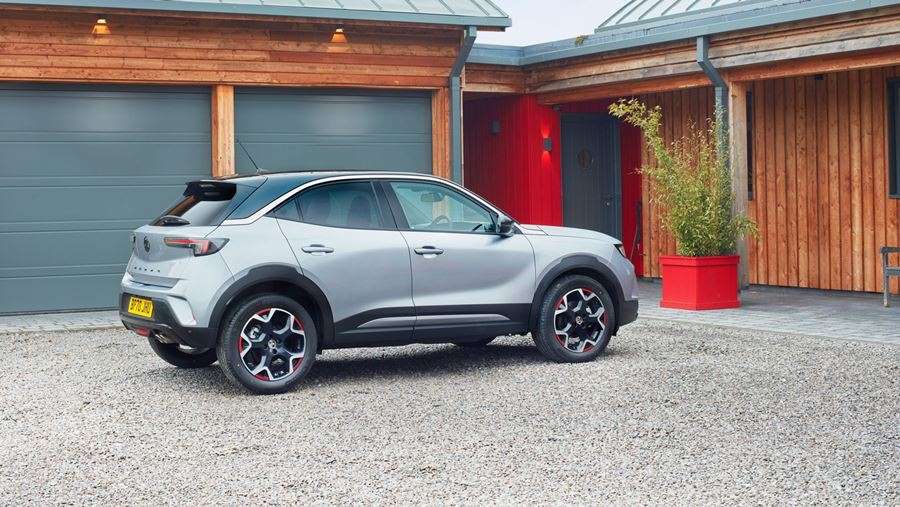
It’s arguably all familiar territory to those who have tried the latest Corsa, or Peugeot’s 208/2008 or Citroen’s C3 and C3 Aircross. The engine has a properly characterful gargly three-cylinder engine note and can get out of its own way, too.
When mated to the eight-speed auto, shifts are smooth in auto and can be controlled by pressing the ‘M’ button on the shifter – the new Mokka comes with wheel-mounted shift paddles. They’re a tad plasticky in feel but they manage not to surprise the auto ‘box when a shift is requested, so there’s little to no lurching when you want a different gear.
What about the Mokka’s handling?
If you’ve not read our Mokka e review already, I’d say that model is fractionally more comfortable in terms of ride quality. There’s an additional softness to the way it rides over lumps and ruts that is missing with the combustion engine Mokka variants. Still, damping is impressive no matter what variant you go for – while it may jitter over lumps a tad more than the Mokka e, the Mokka in general is still a better compromise than the ‘sporty’ Puma and downright irritating Juke.
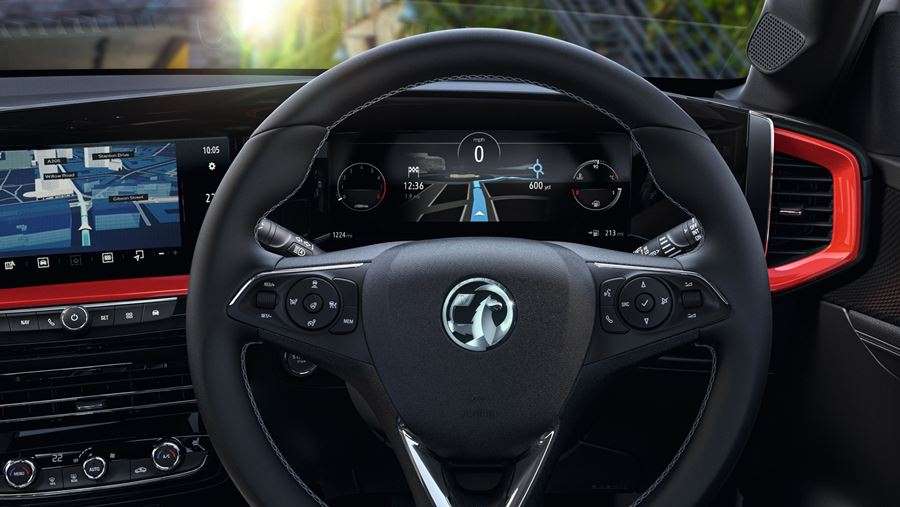
As for overall handling, it’s a sweet blend. Opel/Vauxhall’s engineers have clearly been busy tweaking their own geometry for the steering, adding in welcome weight to the usual PSA’s excessively light steering. It’s the Mokka’s supremely light kerbweight here that does it some favours for keen drivers, with excellent body control and grip available if the moment takes you. Even with the automatic, flicking the drive mode into Sport mode and getting aggressive with your steering inputs… the Mokka is right there with you, ready for action.
Vauxhall Mokka: verdict
Comparing this new Mokka to its predecessor would be a low bar, in reality; the drab looks, dated interior and stodgy drive of the old one is nowhere to be seen here. No, while this new Mokka isn’t perfect – particularly in terms of practicality – we can comfortably say it’s now a small crossover worth looking at. I’d chalk that up as a result for Vauxhall.
Source: carmagazine.co.uk
New Hyundai Kona 2021 review
The Hyundai Kona has been revised for 2021 and we find out just how much it's improved
The updates to the Hyundai Kona improve its overall experience, with an efficient and effective mild-hybrid powertrain, a more composed and comfortable ride, and some useful tech upgrades in the cabin. But these gains aren’t enough to shove the car to the front of the pack; the Kona still isn’t as good to drive as the best small SUVs, and it continues to lag behind the likes of the Renault Captur and Ford Puma on practicality.
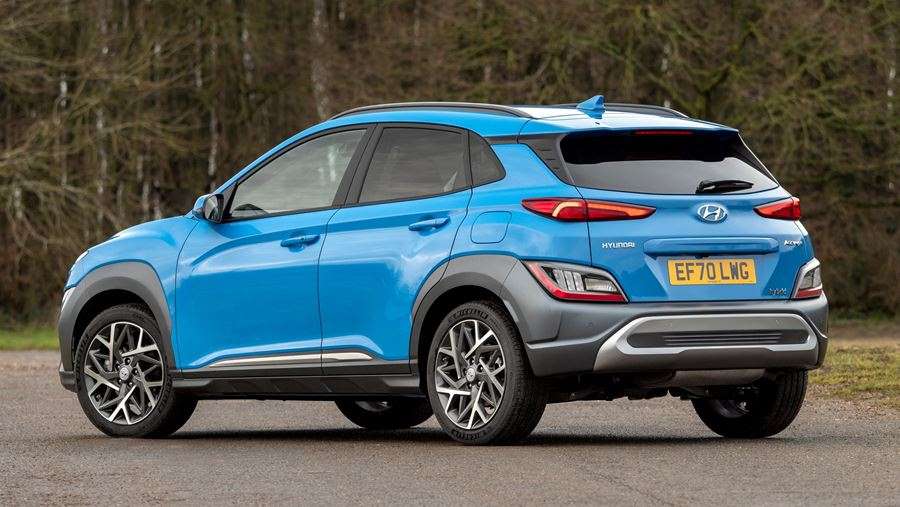
Hyundai will soon have an embarrassment of riches in the small SUV class. The Korean brand has a new offering, the Bayon, on the way in the coming months. And it will be joining a facelifted version of the Kona in the line-up.
Here, then, is the revised version of Hyundai’s ‘original’ small SUV. It’s had a little more than the typical mid-life nip and tuck too; yes, the usual updates like headlights and bumpers are present and correct, but there’s also a redesigned bonnet, and the changes are sufficient to make this car around 40mm longer overall than the outgoing version. The overall effect is to give the car a slightly more aggressive, chunky stance - perhaps even making it more of a crossover and less of a baby SUV. There’s also a new N Line trim level that tries to add a sporty look.
Under the bonnet, the Kona gets an updated range of engines. The 1.6-litre turbo unit at the top of the line-up gains some extra power, moving up to 195bhp, and the diesel motor (yes, here’s a car still available with one) gains a 48-volt mild-hybrid system.
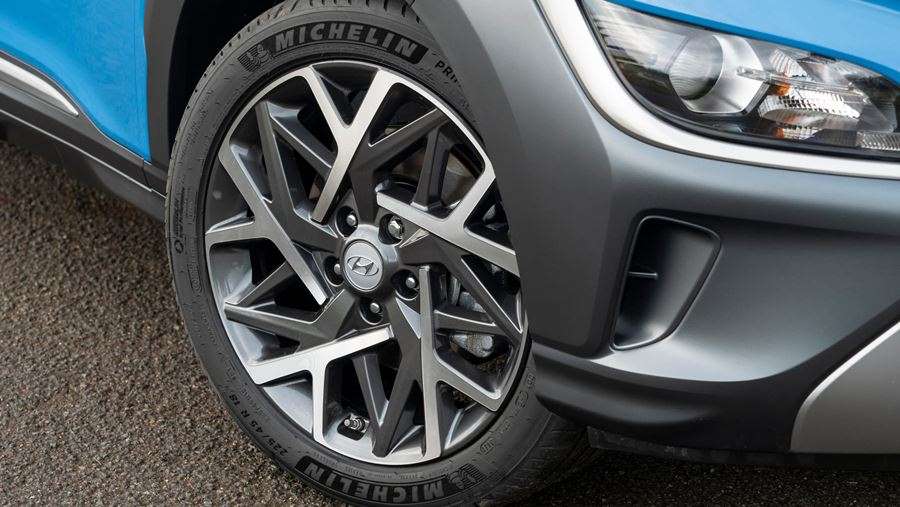
The same tech is also available as an option on the Kona’s 1.0-litre, three-cylinder turbocharged petrol engine - and it’s this powertrain that we’re driving here. The engine itself produces 118bhp, and is the same unit that is likely to appear in higher-end i20s later this year.
The hybrid system uses an integrated starter/generator and a small lithium-ion battery to give the combustion engine a boost when pulling away from rest. It also benefits, though, from Hyundai’s Intelligent Manual Transmission - a six-speed manual gearbox that has no physical connection between the clutch pedal and the clutch. This sensor-based solution means that the engine can be switched off when the car is cruising along - and then fired up again, thanks to the 48-volt hybrid tech, when required.
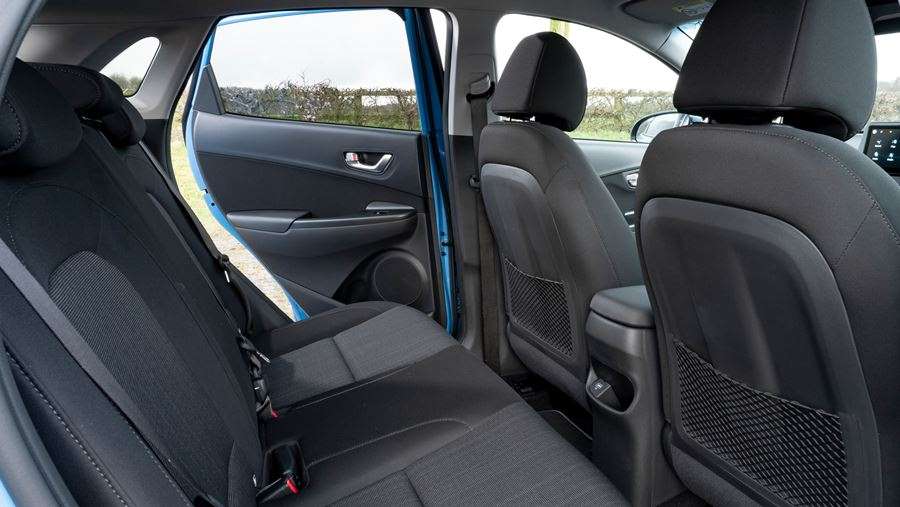
It’s a complex piece of engineering but in practice works extremely well. You won’t feel much extra shove when starting off but once you’re up and running, you’ll have to rely on the visual cues on the instrument panel - the rev-counter needle flicking up and down - to tell that the engine is being cut in and out. It’s incredibly smooth in its transition - astonishingly so when you think that you can be doing 70mph at the time.
The engine has enough power to cope with a car of the Kona’s size, but not quite enough to ever make it feel like it’s capable of really punchy performance. The 0-62mph dash takes a leisurely 11.9 seconds - making the electrified version of this engine slower than the non-hybrid edition in either manual or auto form. It’s more efficient, though, with claimed average economy of 46.3mpg, and based on our experience with the car, this should be achievable in everyday use.
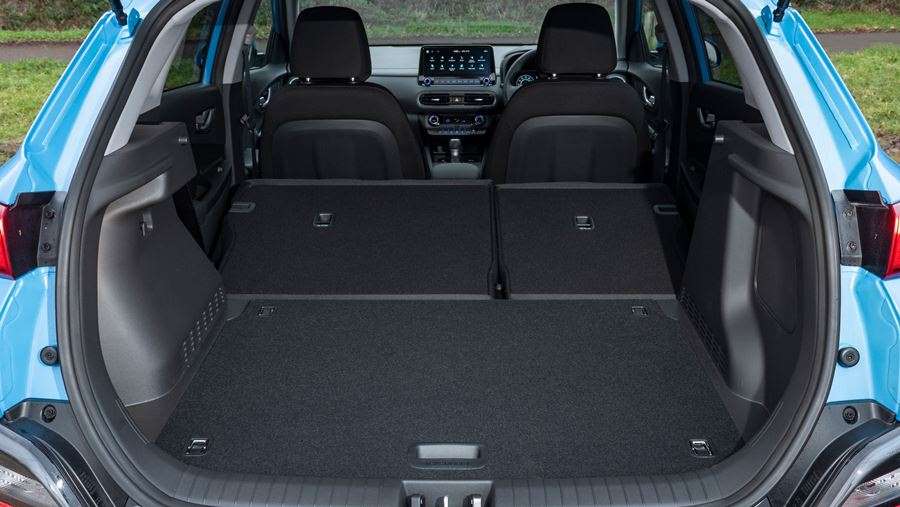
The Kona has also received tweaks to its chassis and suspension, and while they’re not enough to transform the car into a vehicle with real appeal for keen drivers, they do give the model a bit more dynamic polish. The most pleasing development of all is better bump absorption, making the Kona an effective tool on scarred urban roads, even on our Ultimate model’s 18-inch alloy wheels.
Body control feels a little tighter than before too, so while the inert steering and taller body still don’t really play ball and deliver enjoyment on twisty roads, the overall package feels like a more effective compromise than it did before. It’s a result, we’d like to think, of the UK testing instigated by Hyundai’s head of vehicle dynamics, ex-BMW M division man Albert Biermann.
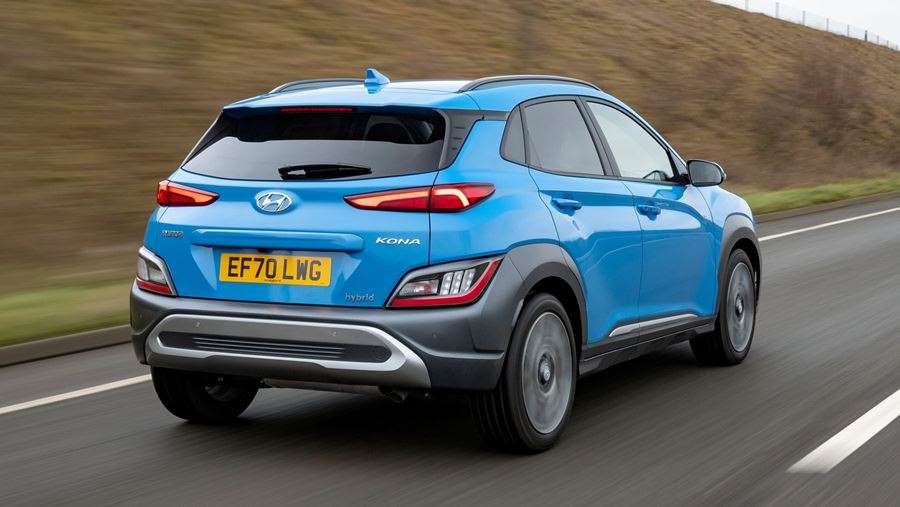
In the cabin the biggest upgrade comes in tech, thanks to a new 10.25-inch digital instrument cluster, as seen first in the all-new i20. It’s crisp and easy to use - an ideal companion, in fact, for the similarly sized infotainment system that comes as standard on this Ultimate trim level. It remains one of the best set-ups you’ll find in any vehicle, frankly, with clear graphics, a great interface and quick responses to inputs. Recent upgrades have improved its connectivity further, thanks to fresh functionality in Hyundai’s Bluelink phone application.
The rest of the cabin gets some new materials but they don’t do much to lift the overall experience. It’s not that it’s badly screwed together or lacking soft-touch fabrics in key areas; it’s just that the fascia is a sea of black, grey and dark grey plastic, with only the very occasional flash of chrome to brighten proceedings.
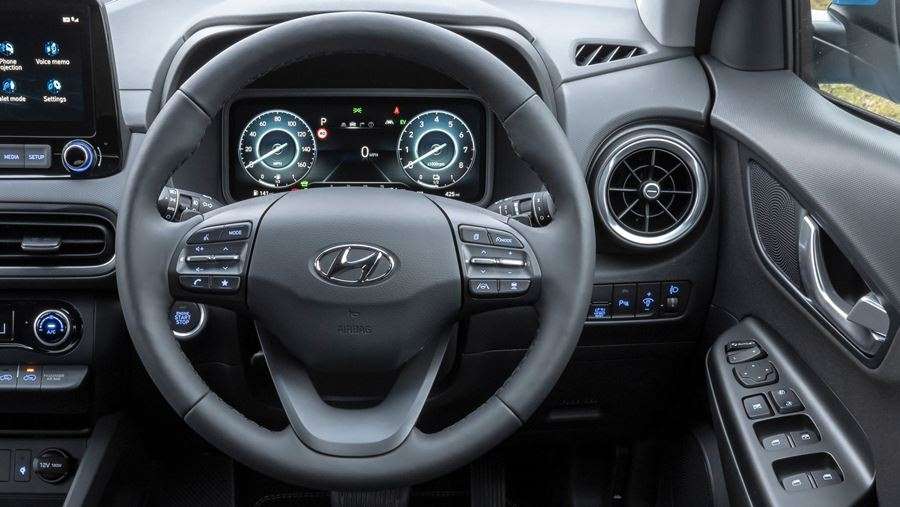
Nor, it must be said, has the facelift done anything to address one of the Kona’s key weaknesses: rear packaging. Two adults can fit in there, even behind a couple of six-footers, but once in place, they’re unlikely to thank you for anything approaching a long journey.
The boot remains pretty unimpressive too - not helped, still, by a relatively high floor that’s designed to accommodate the circuitry of the hybrid and pure-electric editions. The Kona’s capacity is 374 litres, so it isn’t going to challenge the Renault Captur, Peugeot 2008 or Ford Puma on practicality.
Source: autoexpress.co.uk
Audi Q5 Sportback review
Audi has expanded the popular Q5 SUV range with a slightly sportier-looking, low-roofed variant. Predictable this model may be – but with good reason, as the less-bulky profile appeals to buyers previously reluctant to go for the boxy bulk of a traditional SUV
Taking cues from the succesful A5 Sportback, the Q5 Sportback joins the Q3 Sportback and electric-only e-Tron to give Audi customers a choice coupe-SUVs to complement their full-sized sister cars. It's a sensible recipe, too, taking the five-door practicality of the A5 Sportback and adding ground clearance and Quattro all-wheel drive on all but the least powerful model. It takes on the established Mercedes-Benz GLC Coupe, among other less direct competitors.
Just a few centimetres longer than the regular, boxy Q5, the Sportback retains ample room for five with just a small reduction in headroom. A new, optional seating system – rear seat bench plus – introduces a sliding bench and multi-position reclining backrest.
What's new about the Audi Q5 Sportback?
Although much of the Q5 Sportback's engineering and technology is shared with the regular Q5, no-one buys a sporty-looking SUV like this hoping they won't be noticed. Audi's drawing attention to the new model with a new lighting technology, OLED rear lights.
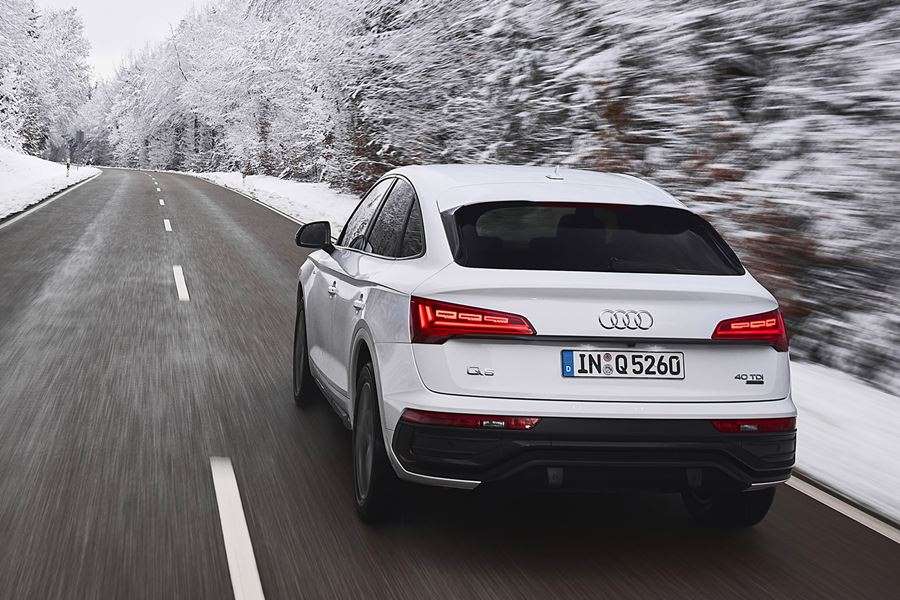
These multi-segment units don't just use a bright, low-power technology (the same technology you'll find in high-end smartphone screens) for shattering the darkness. Different patterns and configurations are possible, with a safety system ensuring your driving-mode signature becomes a full set of illumination as cars approach from behind.
If you thought dynamic indicators had helped Audi stand out on Britain's motorways, this new animated tail-light tech should really grab you. Even without the fancy showcase, OLED lighting is more consistent and even, ensuring that light signature is clear from every angle.
What's under the skin?
There are no surprises here - the Q5 Sportback offers a 2.0-litre diesel or 2.0-litre petrol (more details below). Both are four-cylinder units with 204hp available in the diesel. Diesel models make use of twin-dosing AdBlue selective catalytic reduction (SCR), which in other Volkswagen group cars and vans has proven very successful in reducing real-world NOx output.
Emissions will be further reduced with two plug-in hybrid models when they come on stream later. Care more about performance than your green credentials? There's a diesel-powered SQ5 Sportback too.
Sharing technology with the Q5 means a wide variety of options, including standard, adaptive and air suspension - the latter can raise the car by 45mm for dirt roads, and lowers it by 15mm for improved economy at speed. Steel springs are set up for a sportier feel than the standard Q5, further assisted by optional adaptive dampers and optional dynamic steering. Speaking of options, there are up to 21 different designs of wheel available, from 18- to 21-inches.
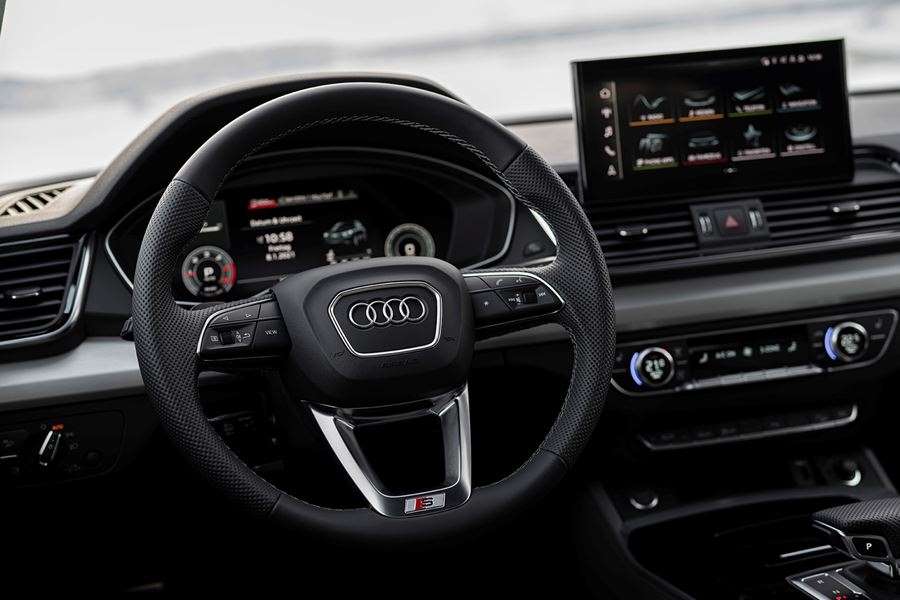
What's it like inside?
Audi's well-regarded MMI - MultiMedia Interface - has been revised and the Q5 Sportback benefits from the latest updates including an infotainment touchscreen with handwriting recognition, improved voice control and comprehensive steering controls.
Mounted in the centre of the dashboard, the main display is 10.1-inches. Ahead of the driver Audi's now-familiar 12.3-inch Virtual Cockpit benefits from the latest developments including hazard warning messages, information about obstructions in the road and traffic-flow awareness to help plan journeys with the least amount of interruptions.
The low-roofed Q5 Sportback is a roomy car and can carry 1,480 litres of cargo with the seats folded. With them raised, the luggage area is 510 litres – on models with the optional bench this can be increased to 570 litres at the expense of rear legroom.
What's it like to drive?
Unsuprisingly, the Q5 Sportback is very similar to drive to its Q5 Cousin. We sampled the range briefly in Germany and can report that it is a refined and effortless cruiser as you'd expect it to be. Sadly, it's not perfect – the V6-powered 50 TDI lacks response away from the lights, and despite e-boost from its mild-hybrid system, it's hesitant to take off, and in busy situations it can feel dreadfully sluggish.
The good news is that the 45 TFSI and 40TDI are not similarly affected. Also, regardless of which engine you choose, there is absolutely nothing wrong with the way these Sportback models handle and ride. On 19-inch wheels, it's stable and planted on the road with unwavering accuracy whatever the surface conditions. In low-grip conditions, the grip and poise is particularly impressive.
The most sporting SQ5 model is very impressive all round, with bags of performance. Despite weighing a portly 2085kg, it will sprint from 0-62mph in 5.1sec from 0-62mph and tops out at a limited 155mph. It's a mild hybrid that can regenerate up to 8kW under braking and will coast with the engine off for up to 40 seconds. Handling and ride are both excellent, too.
Buyers who venture off-road on a regular basis should consider the height-adjustable air suspension together with the side-to-side rear sport differential. Not surprisingly, the air springs also further cushion the ride, lower the body a tad at speed and have the rear end kneel down by 55mm to facilitate loading and unloading.
What models are available?
This is a diesel-centric line-up, at least initially. The model range starts with the 2.0-litre 204hp 40 TDI. Other diesel models will include the 163hp 35 TDI, the 285hp 3.0-litre V6 50 TDI and the mighty 355hp SQ5 Sportback.
There's also a 265hp 2.0-litre four-cylinder turbo petrol engine (the 45 TFSI) – but it will get more interesting (and tax efficient) once the two plug-in hybrids join the range later in 2021. All models have an automatic transmission system, regardless of whether they are front- or four-wheel drive.
Should you buy an Audi Q5 Sportback?
If you're a regular Audi Q5 buyer and fancy something sleeker, here's your next car. It's a class act, mechanically and in terms of fit and finish, but it's not perfect. Although it's a mild hybrid, it feels like a step behind its PHEV rivals and will look old-hat compared with the upcoming all-electric Q6 E-Tron.
We've yet to try it against its immediate rivals, the BMW X6 and Mercedes-Benz GLC Coupe, but the Audi's classy interior and wide range of petrol and diesel engines stand it in good stead – even if it's likely to lag behind the BMW for steering feel and handling.
It's another premium, sporty-looking SUV so you can sit high up, feel safe, and still have a car with more kerbside appeal than a large box on wheels. As it inherits technology and styling from the rest of the Audi A5/Q5 range, it's a known quantity both for reliability and comfort, and for making the right impact on your neightbours when you get it home.
It's more expensive than the car it's based upon and Audi feels its customers will be prepared to pay the premium. The Q5 Sportback is a safe buy, and one that will remain in demand new or used as the UK heads towards the ban on new petrol and diesel car sales, and the SQ5 Sportback is quite a sendoff just as the e-Trons start to take over...
Source: parkers.co.uk
Sales of refreshed Mazda CX-5 started in Europe
The Japanese manufacturer has slightly redesigned an important member of the Mazda family - the CX-5 SUV. Sales in Europe have started, and the price in Great Britain is around 27,000 pounds.
The Mazda CX-5 was first unveiled in 2012 and was the first to embrace the Kodo design language and Skyactive technology.
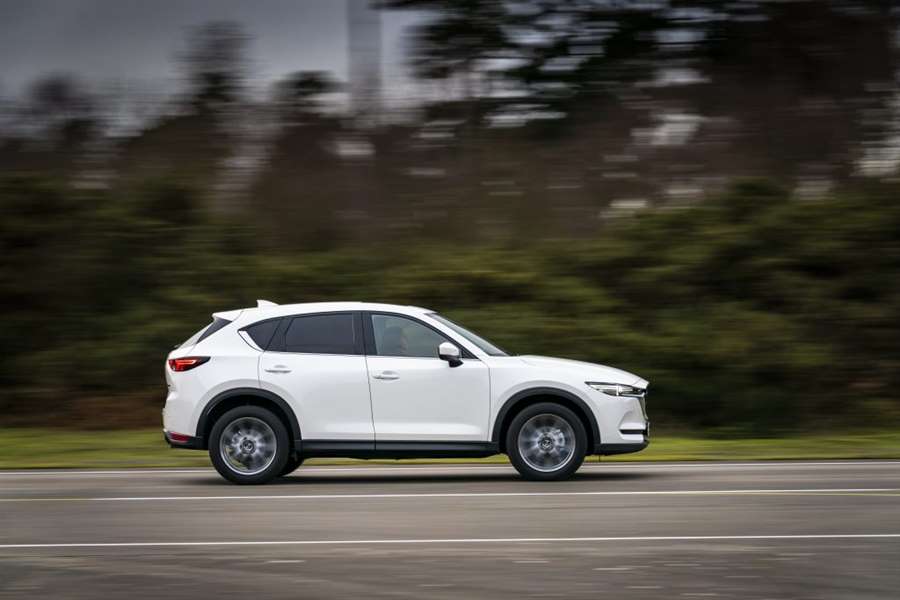
So far, 490,870 Mazda CX-5s have been sold in Europe, but still much more is sought outside the Old Continent, so globally that number is as much as 3.1 million, which makes this SUV the best-selling Mazda model.
An upgraded version of Mazda's mid-size SUV, the CX-5, brings innovations in technology, improved driving dynamics, and reduced CO2 emissions.
Engines and transmissions have also undergone slight improvements, so, among other things, the 2.2-liter Skyactive-D diesel engine with 184 hp is now offered for the first time with front-wheel drive.
The CX-5 also arrived in some markets in Europe in a version with a 2.5-liter Skyactive-G petrol engine of 195 hp, and there is a standard two-liter with 165 hp, which is offered with both front and 4 × 4 drive.
Changes to the engines have resulted in a cleaner and more dynamic ride, so, for example, the accelerator pedal has been optimized, which is now more responsive than before, then the engine, but also the six-speed automatic transmission.
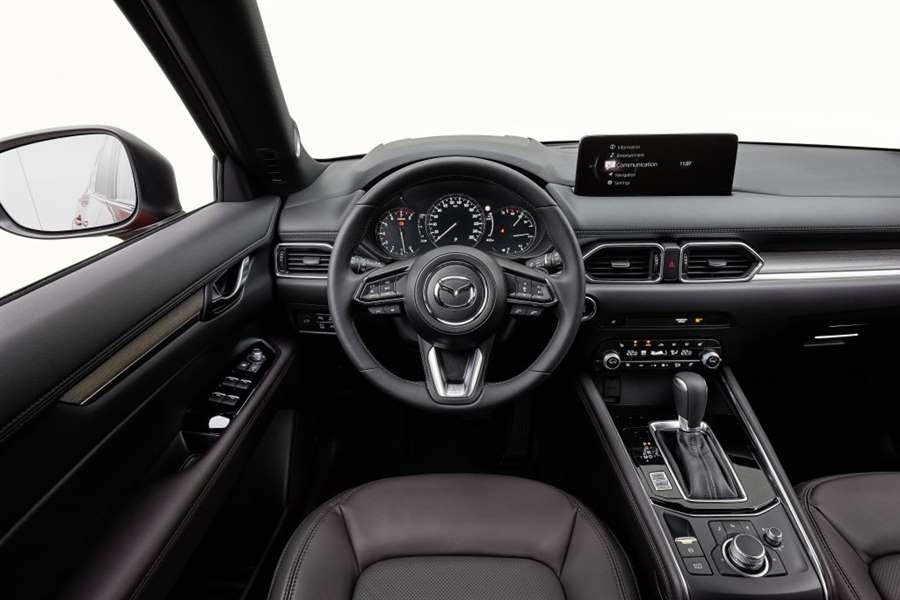
Now this SUV is also equipped with an improved HMI infotainment system, which is displayed on a larger 10.25-inch display, faster response and a cleaner display than before. Controller handling has also been improved, and new connectivity options for the Mazda app have been introduced.
In addition to the restyled CX-5, Mazda also offers a special edition of this SUV to mark the brand's 100th anniversary, called the Homura.
In Japanese, the word means flame, and this version differs from the standard ones by special black details of the exterior and interior, as well as 19-inch wheels.
2021 Lexus UX200 F Sport First Test: Experience or Appliance?
This compact luxury crossover isn’t the user experience we were hoping for.
Your phone, laptop, smartwatch, heck, even your smart speakers are all a massive pain in the neck. Not for you, but for the people who made them. User experience and interface designers agonize over products for months or even years to deliver an intuitive user experience, and you always notice when they haven't. It's the same story for cars like the 2021 Lexus UX200 F Sport.
Engineers spend countless hours working through endless permutations of designs so they can get the little things like the detent on that volume knob just right. It's all part of an endless quest to satisfy the user. So when we see the letters "U" and "X" arrive emblazoned on the rump of a small subcompact luxury Lexus SUV, the expectation is a satisfying user experience. The only problem is that isn't quite what the Lexus UX200 delivers.
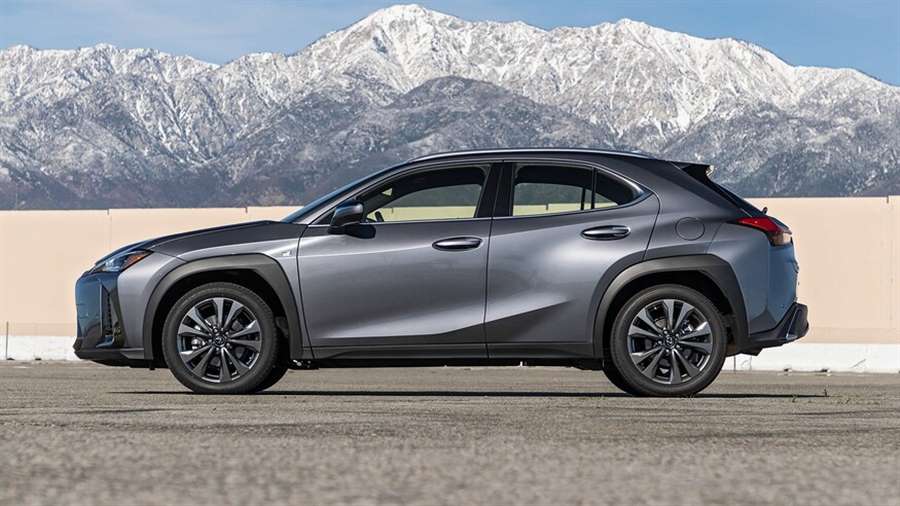
This miniaturized SUV belies both the quality and the satisfaction a Lexus badge normally promises, and the problems start with the UX's pee-wee powertrain. Its 2.0-liter I-4 makes 169 hp and 151 lb-ft of torque, which makes the Lexus one of the slowest vehicles we tested in 2020. At 8.9 seconds to 60 mph, it's slower than much less expensive compact SUVs such as the Mazda CX-30, the base Kia Seltos, and even the Hyundai Venue SEL (which makes 48 hp less).
Sometimes a car feels quicker in the real world than its test numbers would leave you to believe. Sadly, that's not the case here. The UX feels just as breathless on the road as it is on the dragstrip. Merging onto freeways or passing on open roads demands you bury your right foot into the carpet. At that point, the little four-banger shoots to its 6,600-rpm redline and stays there in a perpetual shriek that's about as enjoyable as using a sandpaper Q-tip.
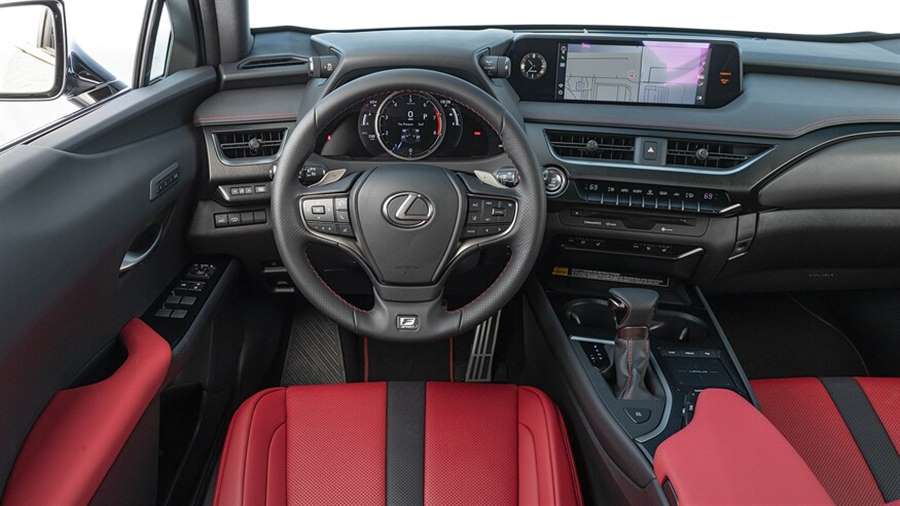
There are no two ways about it: This is a slow car, and despite the F Sport badge, there's little redemption when the going gets twisty. The UX's all-season tires give up grip quickly, and its 27.9-second figure-eight time at a 0.60 g average rank it near the bottom of all the vehicles we tested last year. The Mazda CX-9, a proper three-row SUV that weighs three-quarters of a ton more than the UX, logged a faster lap and a higher average g than the Lexus managed.
As for the UX, road test editor Chris Walton found the steering reasonably precise at the limit but bemoaned the UX's "10-speed" CVT, saying it was "slow to respond and kick down to a proper ratio." The transmission doesn't have "gears," as such, but it emulates a number of simulated ratios, and for most of my driving the CVT was in too low of a "gear," even in Normal mode. I resorted to putting the car in Eco mode for the majority of my driving just to keep the revs down and the engine-sound out of the cabin.
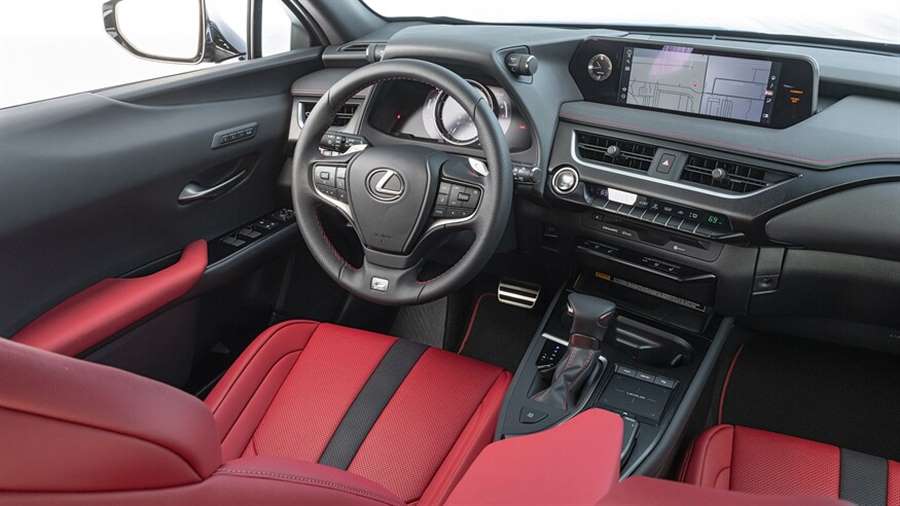
We noted issues with the throttle map on the previous UX we tested, but some software changes to the 2021 model have, thankfully, made the throttle response more linear and easier to modulate. Dynamically, though, that's the solitary bright spot for the UX, and it's not a particularly praiseworthy one.
Thankfully, the ride provides some relief from the lackluster powertrain of the Lexus. Over small lumps and fissures in the road, the UX can be crashy, but all in all, it rides well over most any surface and is more comfortable than rivals such as the Mercedes GLB and Jaguar E-Pace. A big part of that comfort is down to the excellent F Sport seats. They're supportive, heated, cooled, and trimmed in a luscious leather that makes spending time in them the best part of the whole car.
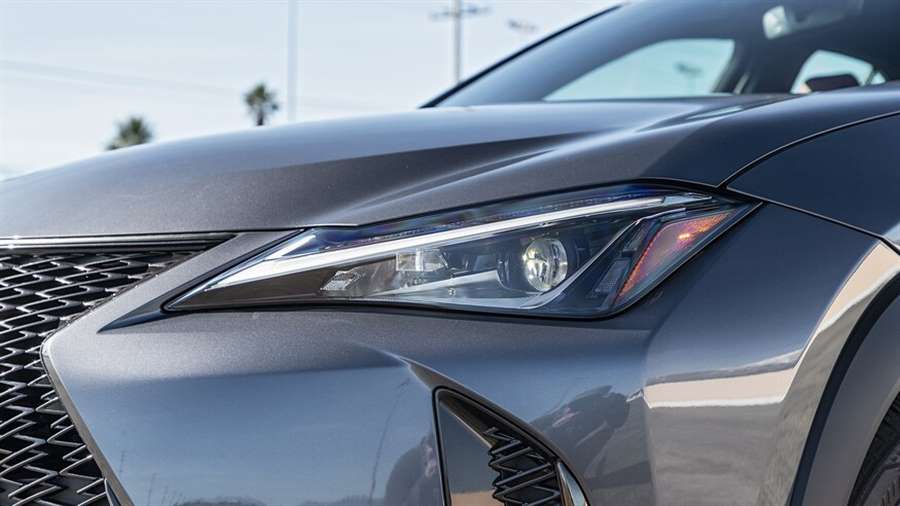
The rest of the interior, on the other hand, is largely where the user experience falls flat. One example: Just beneath the crisp, bright infotainment display is a well-organized row of HVAC buttons, but the option to turn the A/C on and off is buried under three menus. Plus, Lexus' finicky touchpad makes getting there difficult. Even after Lexus spent years refining and iterating on the system, it still isn't as intuitive or as accurate as the control knob offered by much of the German competition.
The volume knob is located on a funky, flat spar that juts out from the center console. It's supposed to be easy to use if your hand is resting on the lid of the console itself, and it's not necessarily a problem on its own. But once you have a passenger and their elbow takes up the exact position your arm needs to be in to use the volume knob properly, the illusion that this is somehow more intuitive or more interesting than a typical volume knob falls apart. That and the rest of the physical controls located on that spar become unusable.
The steering wheel is much too large for a car of this size, and even though the column is electrically powered, it doesn't telescope out far enough. The bit of plastic at the top of the instrument cluster creaked incessantly in our test car, and the screen resolution in the cluster itself doesn't hold a candle to the likes of Mercedes' MBUX and Audi's Virtual Cockpit. And then there's the excessive wind buffeting—even with both driver-side windows down, there's a literal tornado whipping around in the back of the cabin. You can mitigate it by lowering the rear passenger's side window, but at that point, you might as well be driving a convertible.
The rear cargo area only has 17 cubic feet of free space available (that's less than a Hyundai Veloster), and there's a middling amount of legroom and headroom available to second-row passengers. Now, I know what you're thinking. Here comes Johnny Auto Journalist, picking apart yet another SUV because we are taught to hate them. But you'd be wrong. There are plenty of SUVs, compact or otherwise, that we genuinely love.
On its face, the UX200 should be an appliance, a generalist automobile that takes you from A to B without hassle. Like your smartphone, it should be pleasant to use when you need it to be and out of your way when you don't. Lexus' quest to make it an "experience" with its, erm, eye-catching exterior looks and fussy interior design has only packed it full of compromise.
The user experience that I talked about earlier, the one that designers and engineers fret over, the one that separates good products from bad ones, simply doesn't excel here. The UX is inconvenient at its best and downright irritating at its worst, and for $41,655 there is no way to justify it.
Source: motortrend.com

